Public Pier — No Fishing License Required
“Surf City, U.S.A,” that’s what the town and locals like to call Huntington Beach (and the city went to court battling Santa Cruz for the use of the name). It’s appropriate given the steady stream of surfers to the local waters and sunbathers to the local beaches. The pier itself serves as the focal point for these beachfront activities. Surfing competitions, band concerts, professional volleyball tournaments, you name it, the pier is home to these and many more activities. It’s also home to the thousands of anglers who visit the pier each month, many on a daily basis.
That fact seems kind of funny today because this was a pier that I used to ignore. Newport regulars, myself included, were prejudiced. “Good” anglers fished the deep waters of Newport Pier for bonito; “others” were content to fish Huntington Beach for tomcod (white croaker). It wasn’t that the pier wasn’t nice; it simply offered the wrong kind of fish. Unfortunately, it took years for me to discover the simple fact that there were far more fish than just tomcod at Huntington Beach. In fact, the pier yielded a lot of bonito and large sharks and in many ways fishing was as good or better than that at Newport. But back in the early sixties, I never made the effort to traverse the few miles that separated the two piers, even when nothing was being caught at Newport. Looking back, I wonder what I missed by making that decision.
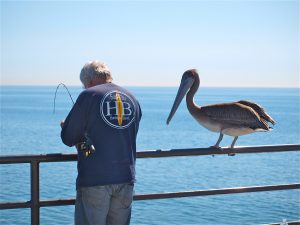
Environment. This is a huge pier, 1,856 feet long, and the area offers an eclectic southern California mix of fishing and non-fishing sights. Located smack dab at the intersection of Pacific Coast Highway (PCH) and Main Street, there always seem to be a mix of tanned SoCal yuppie crews—complete with expensive cars, or hot rodders displaying their ‘50s and ‘60s vehicles (especially when the sun sets in the west). Cruising PCH in your car is a tradition.
On the street corners and entrance to the pier stand orange, green, or purple-haired (and) tattooed girls. They’re competing with Caribbean-types with birds on their shoulders, skateboarding dogs and skate rats. It’s reminiscent of Venice to the north although the surfer dudes and dudettes provide a distinctive flavor for the area.
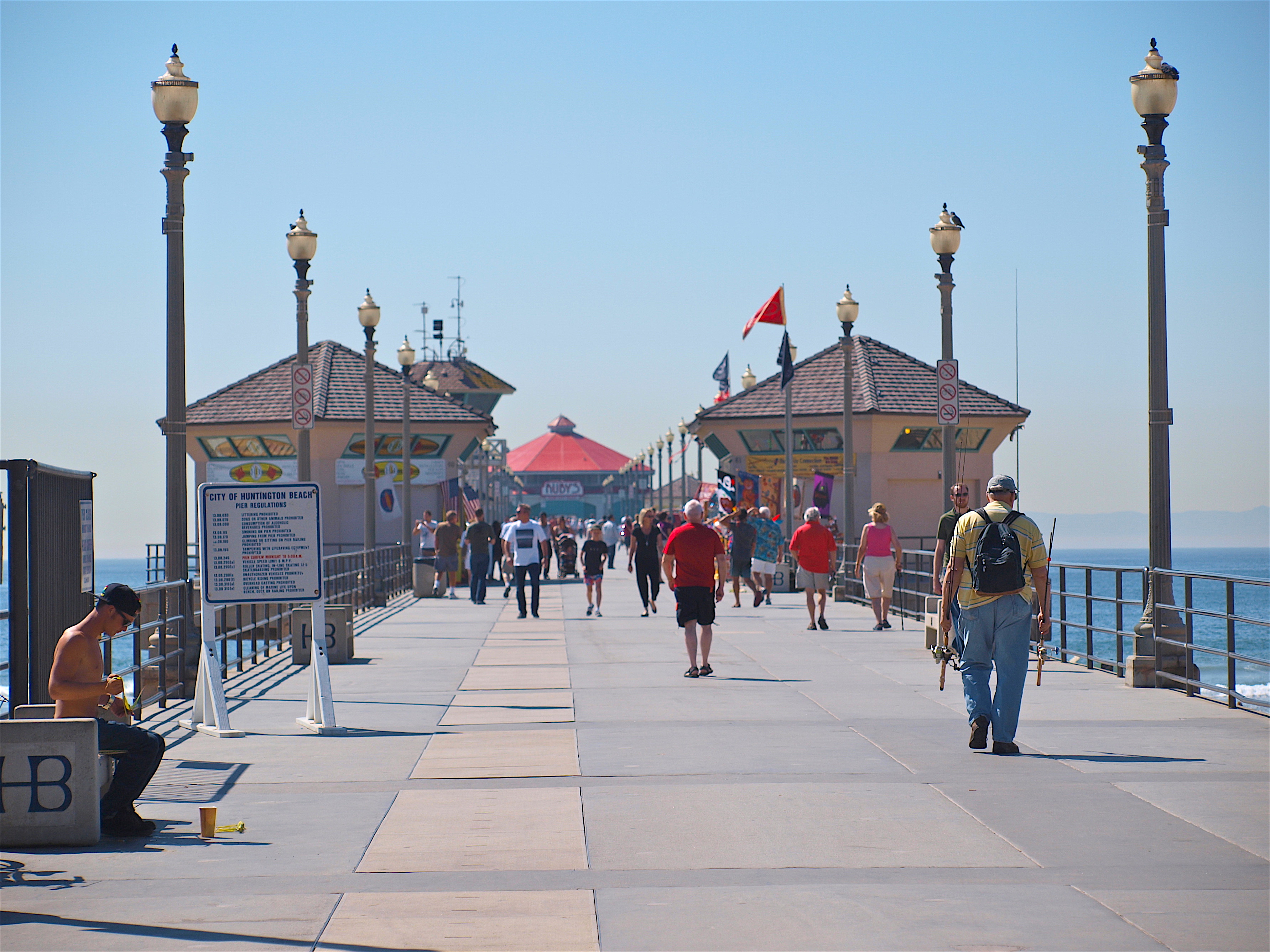
The tourists with their thousand and one languages and dialects increasingly bring in a new element to the scene although their impact is usually transitory. Then again, there are always the un-card-carrying, proletariat pier fishermen, the pier rats (or perhaps prole rats), making the trek out to the pier to test the waters. Our heroes.
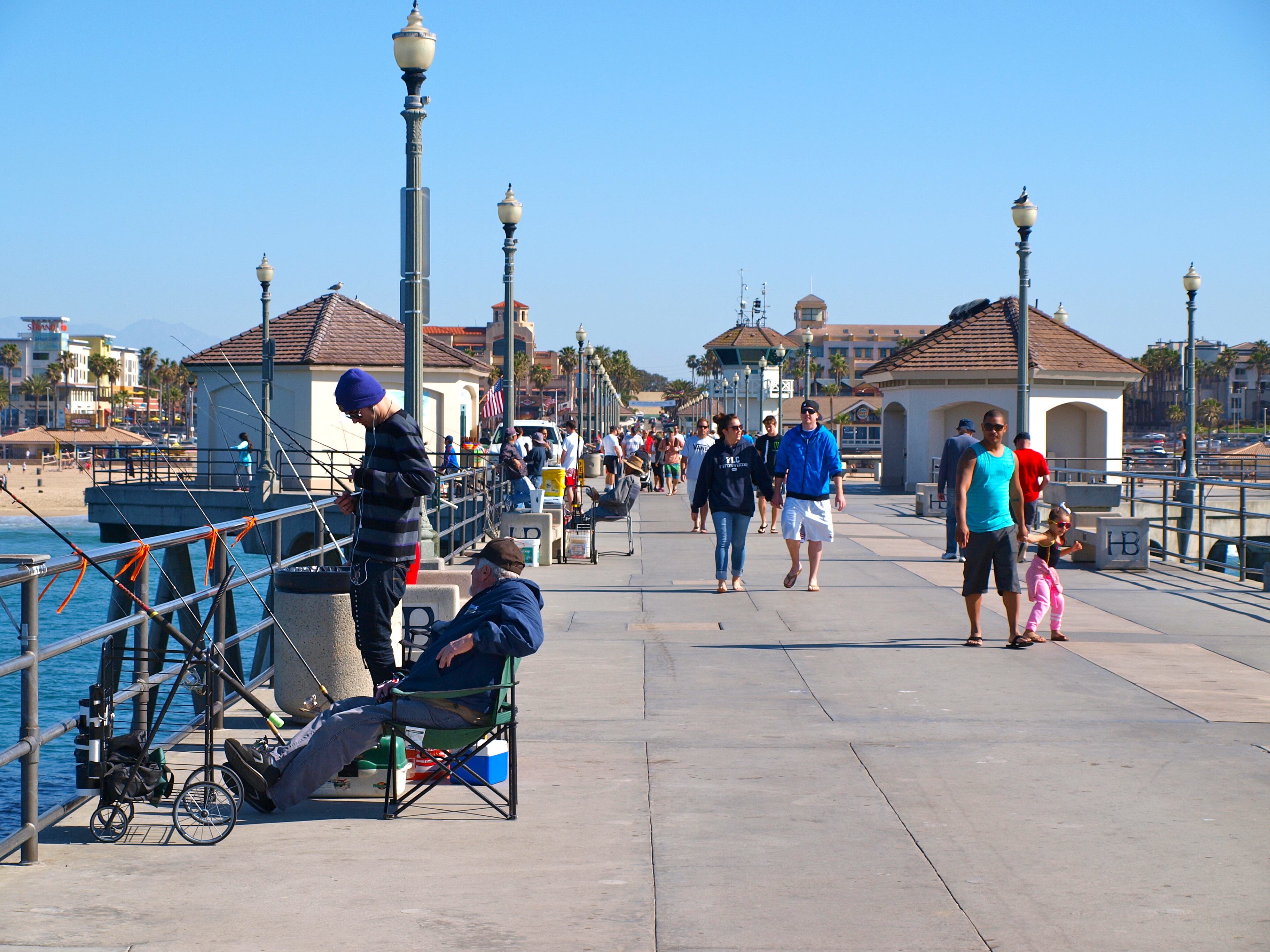
There is considerable water and fishing space to test. The pier sits on the Huntington City Beach while to the south is located Huntington State Beach, to the north is Bolsa Chica State Beach. The beaches run for more than eight miles and are some of the widest in southern California. Offshore is the region known as the Huntington Flats, a sandy-bottom area known for sand bass and halibut. Inshore, the bottom is also primarily sand. There aren’t many rocky areas nearby and the water is not as deep as at the piers on the Newport Peninsula. However, this is one of the piers near an artificial quarry rock reef.
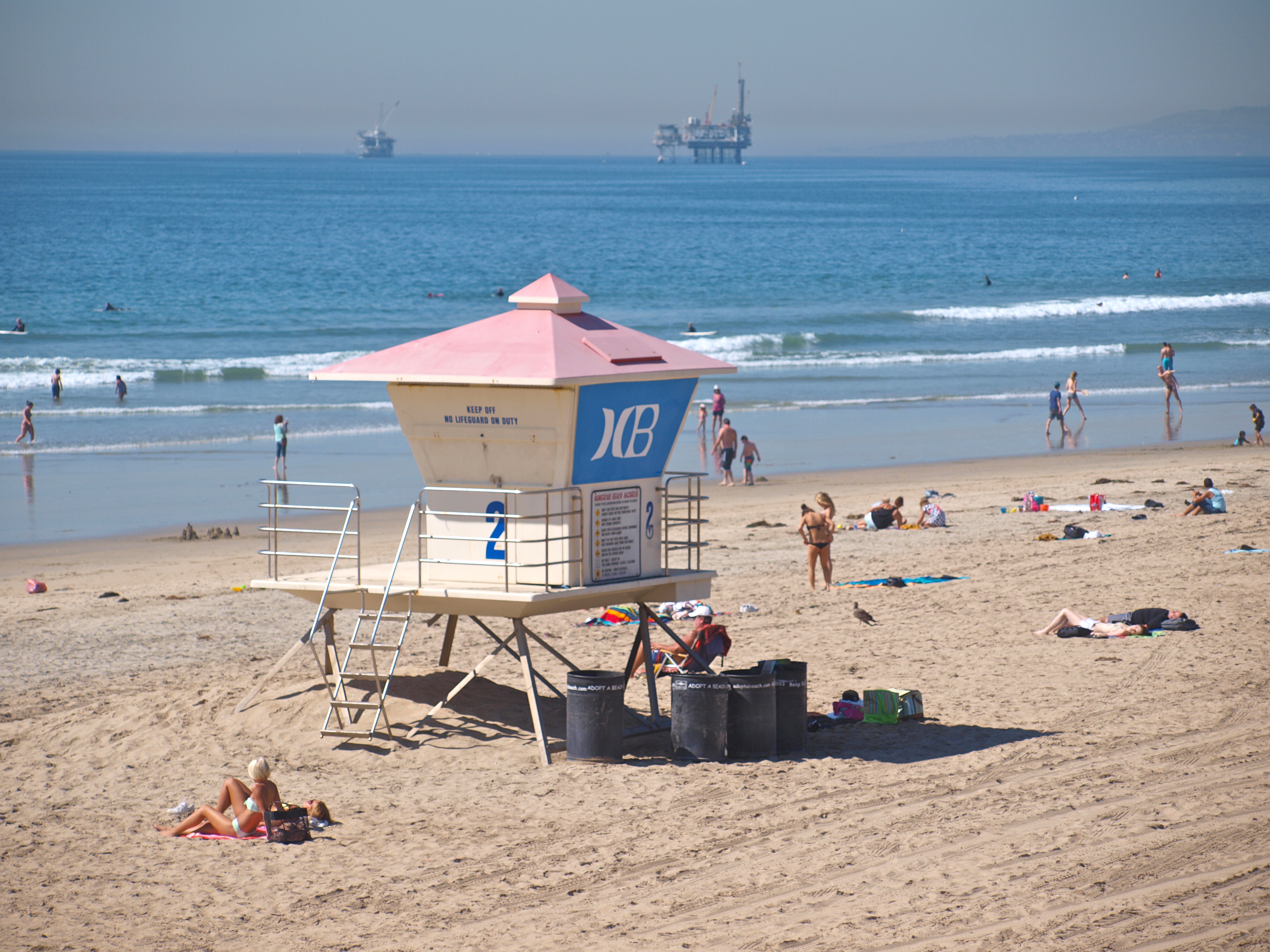
Unfortunately the pilings, once heavily encrusted with fish attracting mussels and barnacles, are now often bare due to city efforts to keep the pilings clean, lean and mean (for storms).
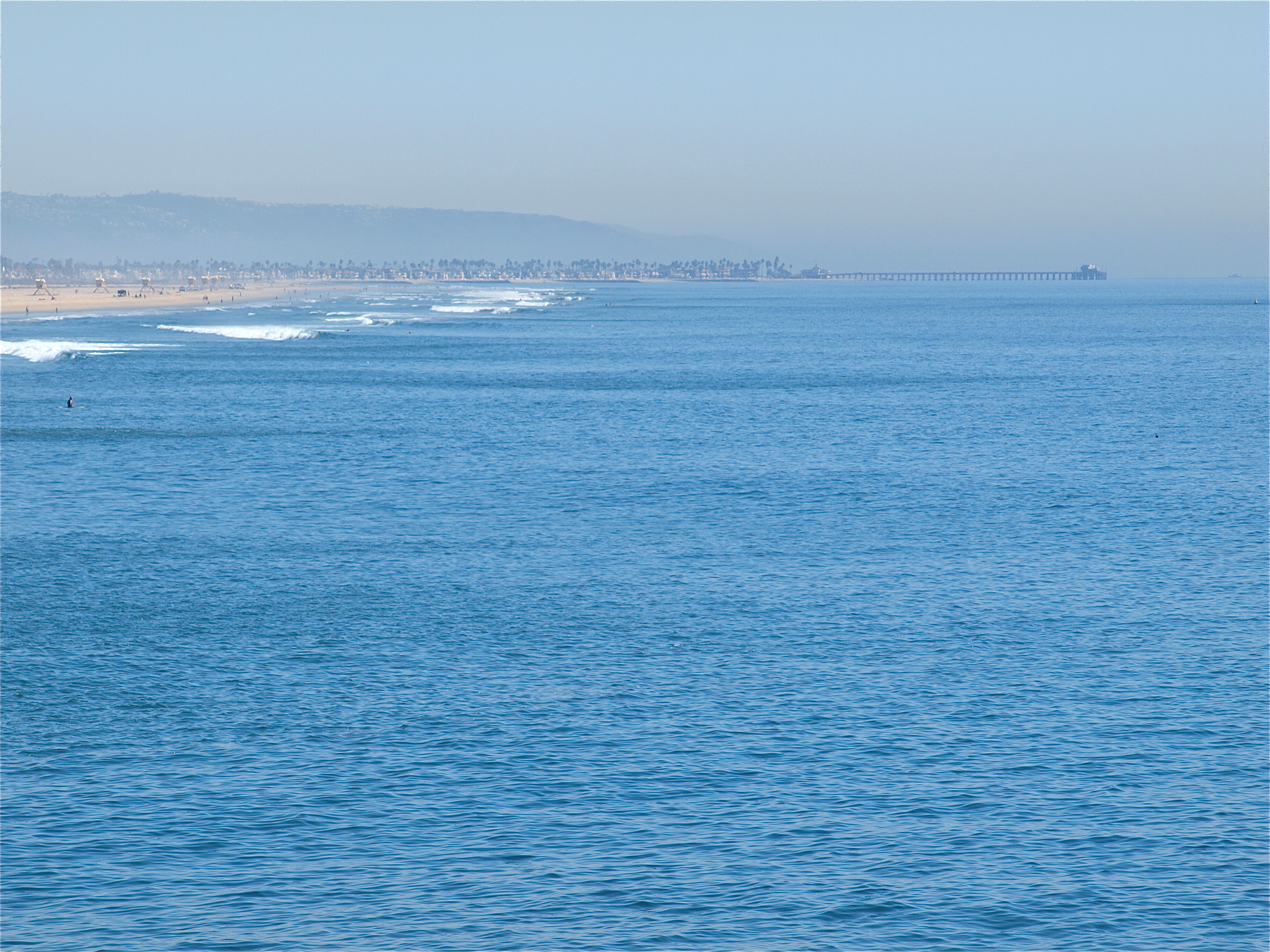
Looking east toward Newport and the Newport Pier
Any discussion of the environment has to include surfers. As said, the city proclaims itself “Surf City, U.S.A.” There are many onshore reminders (businesses at the foot of the pier) and there are generally surfers in the surf area from dawn to dusk.
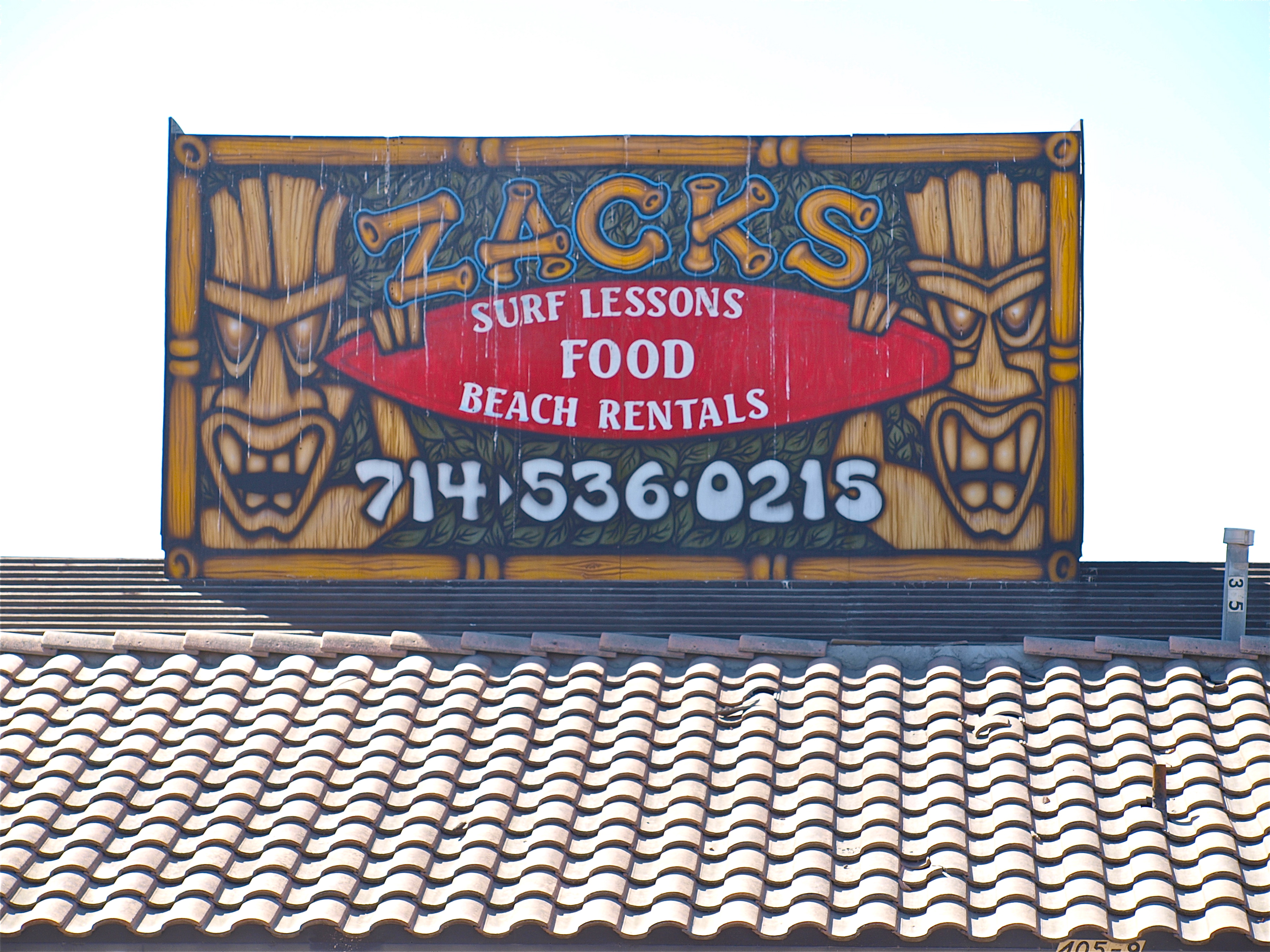
Unfortunately, conflict between anglers and surfers almost seems predestined. One of the very best areas on the pier to fish is the inshore area from the surfline out to about the lifeguard building. This is the home of shallow-water corbina, large spotfin croaker, smaller yellowfin croaker, and barred surfperch. All are coveted species both for pier anglers and surf anglers.
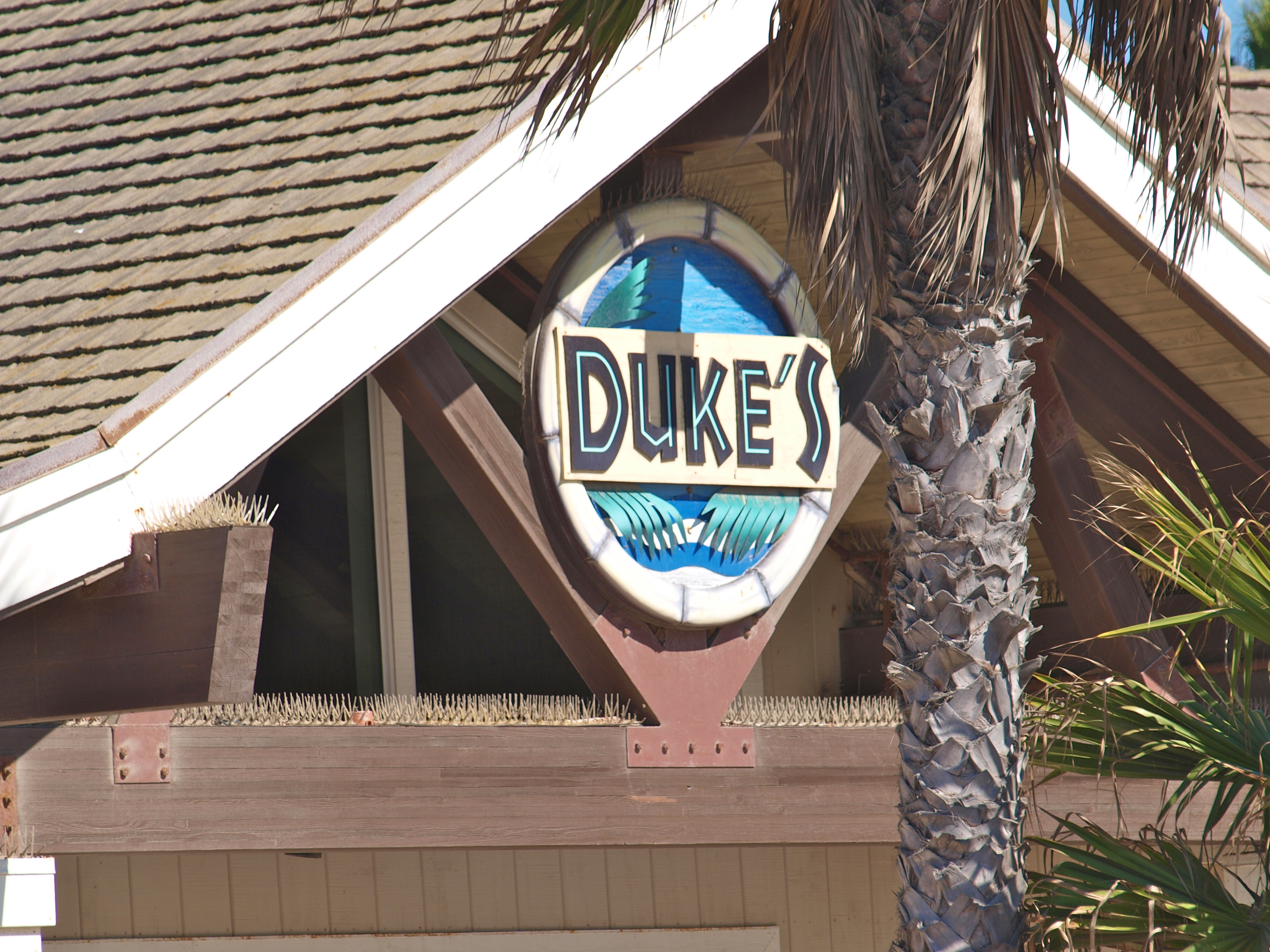
This shallow water area is also coveted by surfers and often they are what’s called SWAs (Surfers With Attitudes). Rules stipulate that surfers must stay a certain distance from the pier, rules that should help prevent surfer-angler conflicts. Rules also say that surfers are not supposed to “shoot the pier” (surf between the pilings) but here the rules seem to just be suggestions and “shooting the pier” is almost a rite of passage.
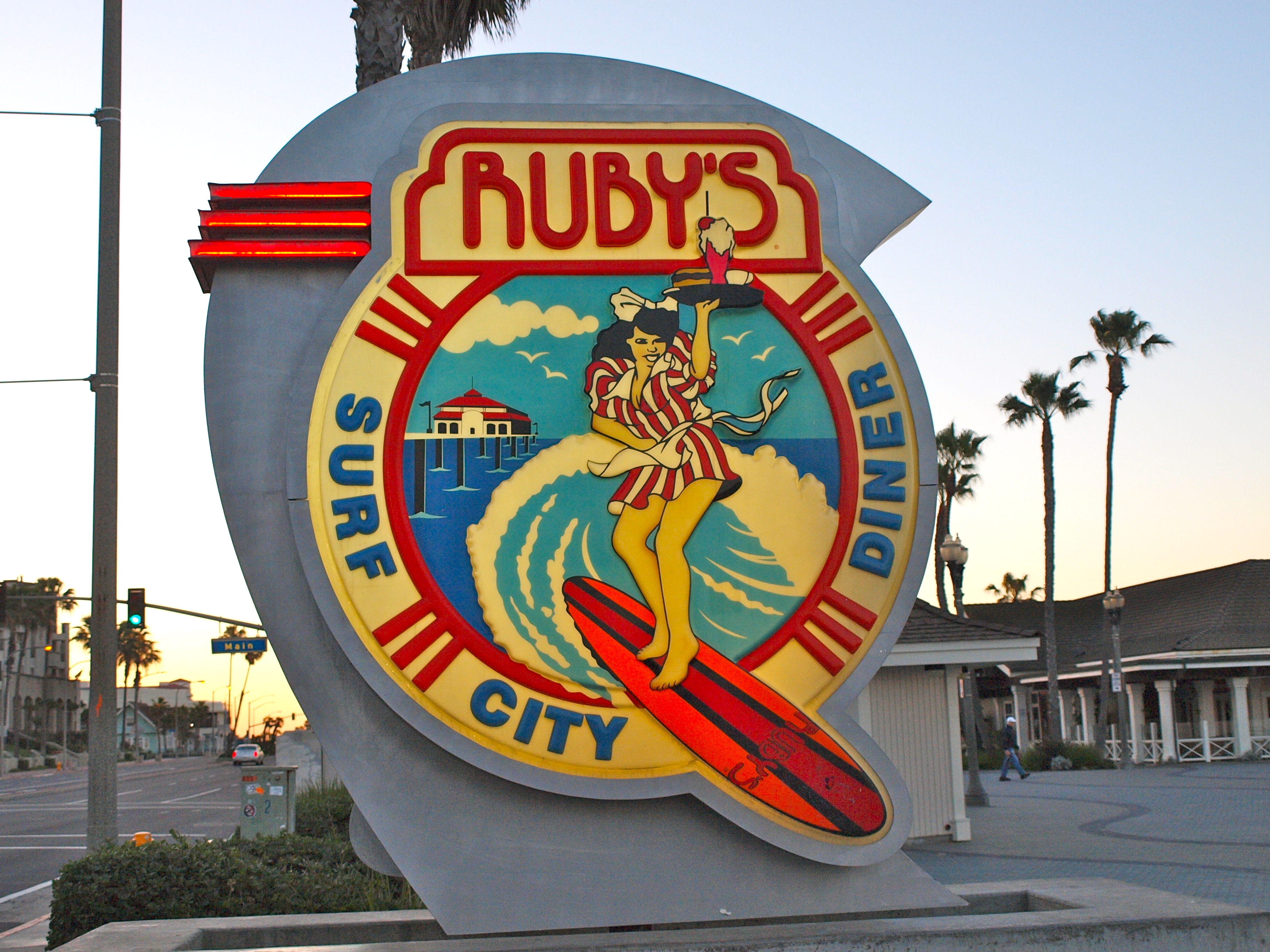
In part the conflict is due to city decisions. When the pier was rebuilt in the early ’90s, the space between inshore pilings was lengthened to provide more room to “shoot the pier,” even though such actions are supposedly illegal. Some would argue that the city itself was inviting surfers to ignore and break the rules.
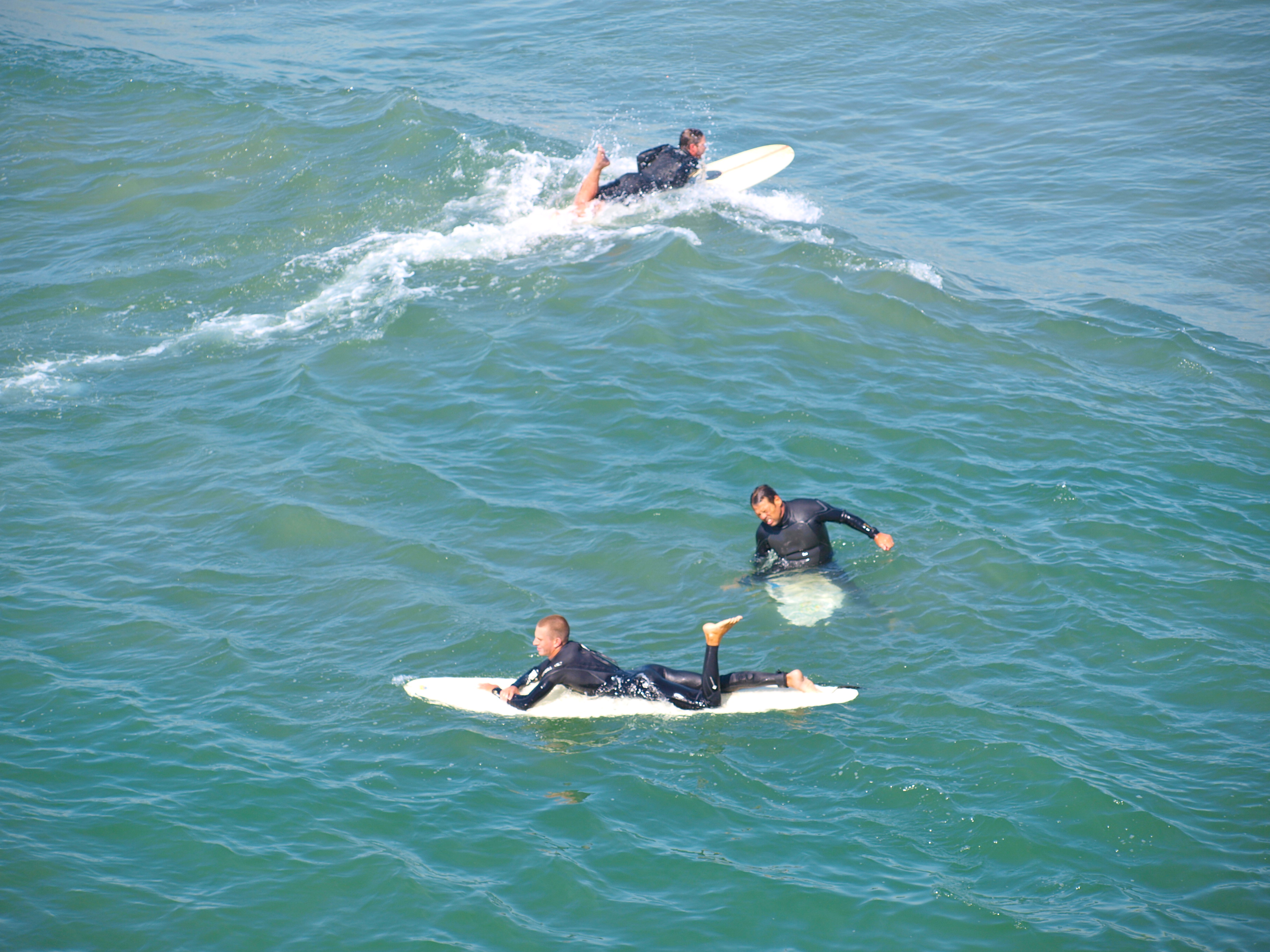
One day (at the old pier) I witnessed several surfers surfing through the pilings and one angler repeatedly being forced to move his line. After shouting at the surfers, and receiving only a one-finger reply, the angler decided to retaliate. He tied a sinker weighing at least five or six ounces directly on to the end of his line. The next time the surfers headed in toward the pilings our noble but impetuous and emotional fisherman aimed and let the sinker fly. Luckily, for both he and one surfer, he missed. But he didn’t miss by much—less than a foot. By this time, calmer heads prevailed and Macho Man realized the danger of his action. He moved. Don’t try such knuckleheaded acts or allow a buddy to try it. Such actions only produce losers, no winners. However, also don’t be afraid to complain to the lifeguards on the pier since they are supposed to keep the surfers away from the pier. Unfortunately, most of the lifeguards are also surfers and sometimes it seems like complaints are simply falling on deaf ears.
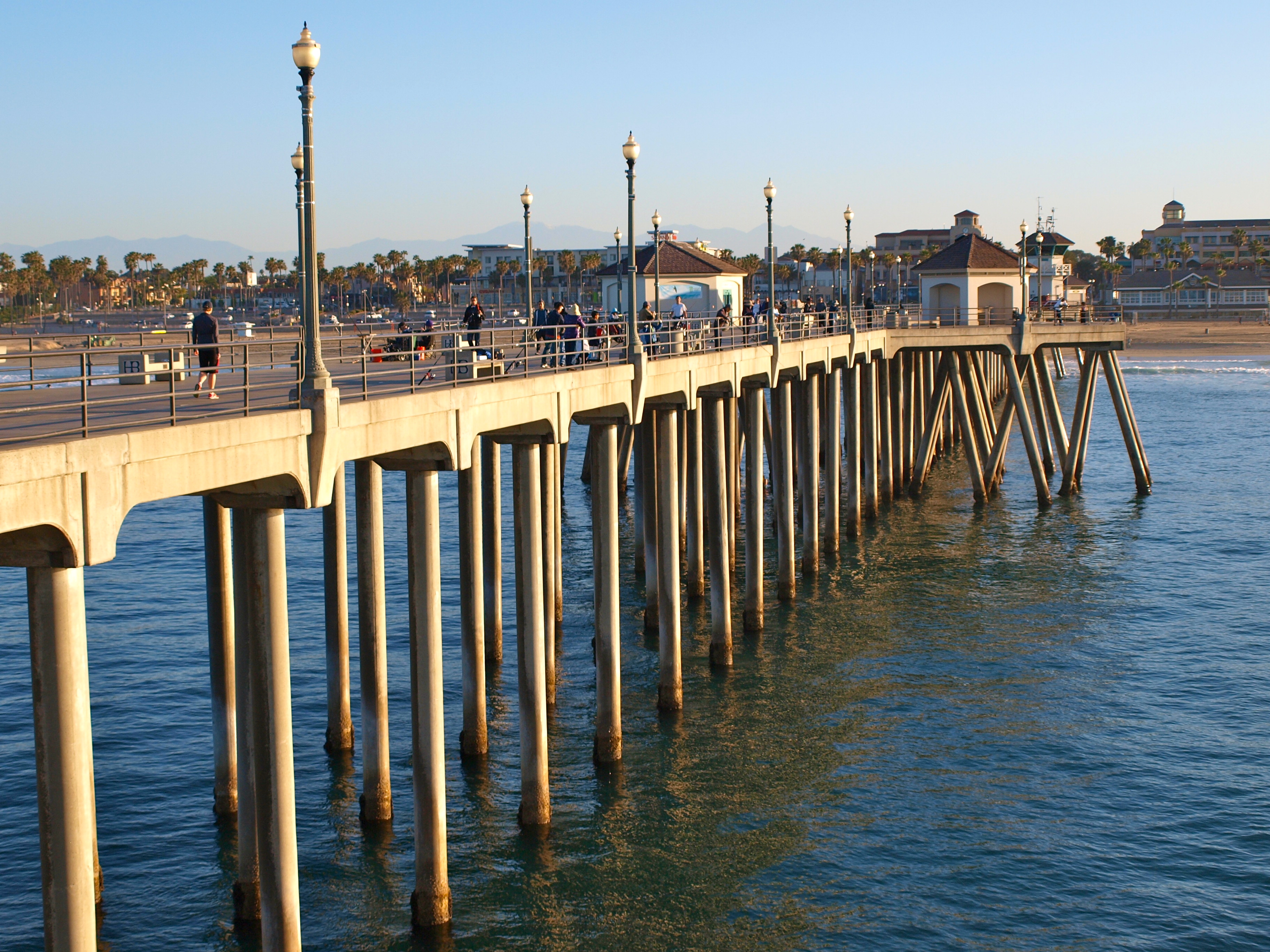
The Fish and Fishing Tips. The pier itself is large and presents somewhat distinct fishing zones. (1) The inshore area preferred by several species of croaker as well as barred surfperch and several small sharks and rays. (2) The mid-pier area that sees an overlap of inshore and deep-water species as well as its own species. (3) The end is where most pelagic species will be caught, everything from sardine, jacksmelt and mackerel to, at times, bonito and barracuda. This area is also the best for the larger sharks and rays. (4) The piling area, basically from mid-pier to the end, which at times seem to be a world onto itself. Although the newbies to saltwater pier fishing seem to automatically head to the end, the regulars know which species they are after and head to the area that provides their desired fish.
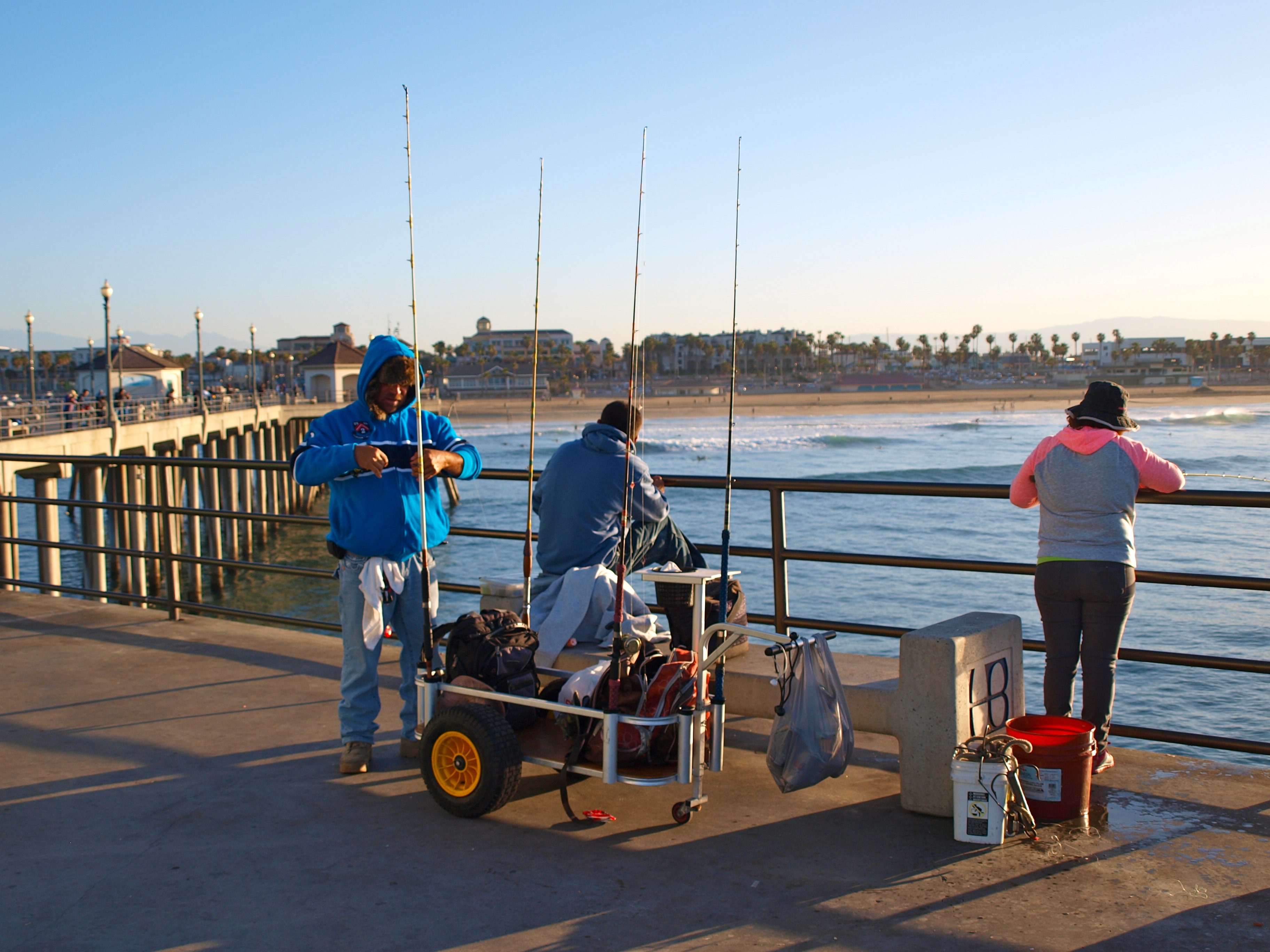
Inshore. Barred surfperch are numerically the number one caught fish in the inshore, intertidal or littoral zone,area. They are joined by several varieties of the family Sciaenidae (croakers) which seem to actually lead the hit parade due perhaps to their size. In the shallowest waters are found corbina, once simply called surf fish and a favorite species for many anglers.
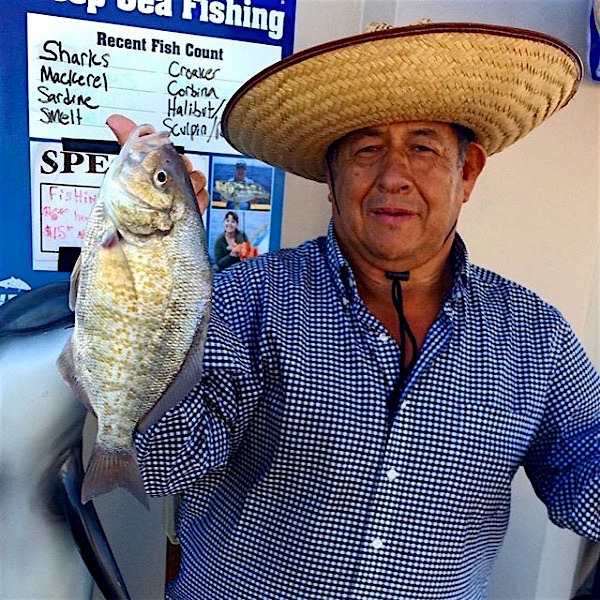
Barred Surfperch (picture courtesy of Let’s Go Fishing)
From just past the surf area out to about the lifeguard tower are found large spotfin croaker, probably the favorite croaker after corbina. Huntington Beach is noted for large spotfins with most years seeing fish in the 5-6 pound range and occasionally fish up to 8 pounds in size. Smaller yellowfin croaker hit throughout the day (and night) while black croaker make occasional showings, but almost always after dark. This area is also good for the croaker-like sargo, a fish that resembles croaker and is caught on the same bait and with the same riggings.
All of these will fall for mussels (especially fresh mussels), ghost shrimp, bloodworms, lugworms, and pieces of market shrimp or razor clams fished on the bottom. If you’re specifically after barred surfperch or corbina, you might also want to invest some time and catch yourself some sand crabs down near the water’s edge; they’re the superior bait for those two species.
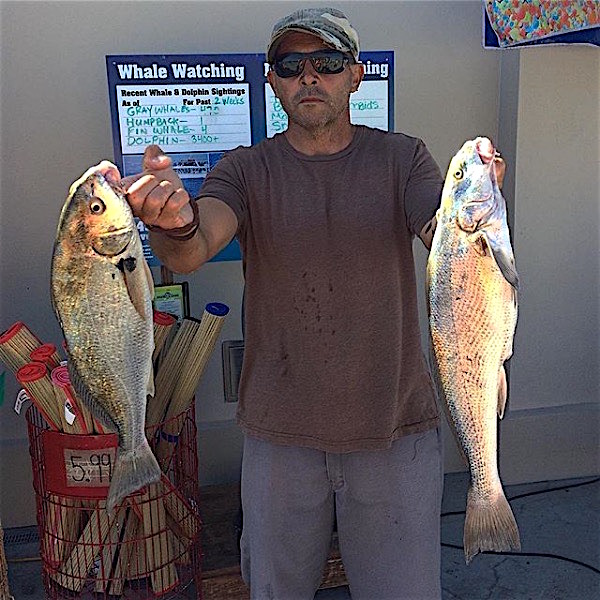
Spotfin Croaker (L) and Corbina (R) — Caught by Wilton (picture courtesy of Let’s Go Fishing)
The most common rigging for these is simply a high/low with size 6 or 4 hooks utilizing a pyramid sinker just heavy enough to hold bottom. Some anglers also like to use a Carolina-type sliding bait leader. For this leader, buy an egg sinker that has a hole through the middle. Run your line through the hole and through a small bead (usually red) and then attach a swivel to the end of the line (which prevents the sinker from sliding down onto your leader). Next attach a 3-4 foot leader that has a size 6-4 hook at the end. This leader works well for the larger croaker—spotfins up to around 6-pounds in size and yellowfins to about 2 pounds in size (although larger fish can be found here. A 28-inch yellowfin was reported in March 2015 which, if accurate, would have been a new state record). The sliding rig aka fish finder rig also has the advantage of being a good halibut rig.
Most years will see these croakers joined by a few of their croaker cousins—white seabass. Usually the white seabass will show up in the spring although a large run of white seabass took place at the pier in October 2006. Most of the time the white seabass will be the smaller, illegal-size juvenile fish that are called seatrout but at times the bigger fish will show up (including a nice-sized fish in May 2016). Unfortunately, the name sometimes confuses newbie anglers who think they may keep the “seatrout” even if they know the size requirement for white seabass. Know the rules AND learn how to identify the fish.
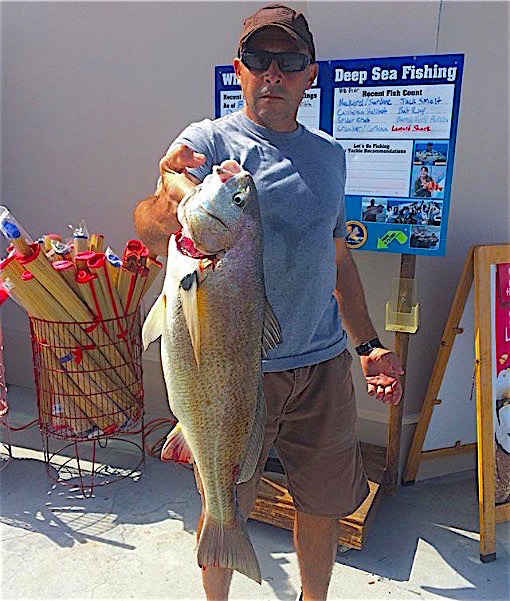
A large Spotfin Croaker caught by Wilton (picture courtesy of Let’s Go Fishing)
As mentioned, the barred surfperch can be taken on the same baits and rigs used for the croaker. However, the perch are also caught on artificial lures. Small root beer or motor-color grubs or Berkeley Gulp (4-6 inch size) seem to catch the most fish and have the most loyal following of anglers.
Best croaker action, for both spotfin and yellowfin is during the mid-summer to fall months, with late July often being the peak period. Spotfins seem to hit year-round while yellowfins are much more scarce during the winter months. Surfperch predominate in the winter months.
Some years will also see runs of zebraperch (Hermosilla azurea) being caught in the shallow-water or mid-pier areas; try frozen peas or corn for these vegetarians. It’s hard to get them to bite so unfortunately most are taken on snag lines much like those used for mullet. It’s legal but doesn’t seem too sporting. Some of the zebraperch by the way are an impressive 3-4 pounds in size.
These inner waters also see a fair share of sharays—small round stingrays, thornback rays (good ‘ol throw-em-backs), some shovelnose sharks (guitarfish), gray smoothhound sharks, and (generally in the spring) small leopard sharks. As usual, the best bait for the rays and sharks seems to be squid or a bloody piece of mackerel (although live mackerel and other small live fish are good bait for the bigger sharks).
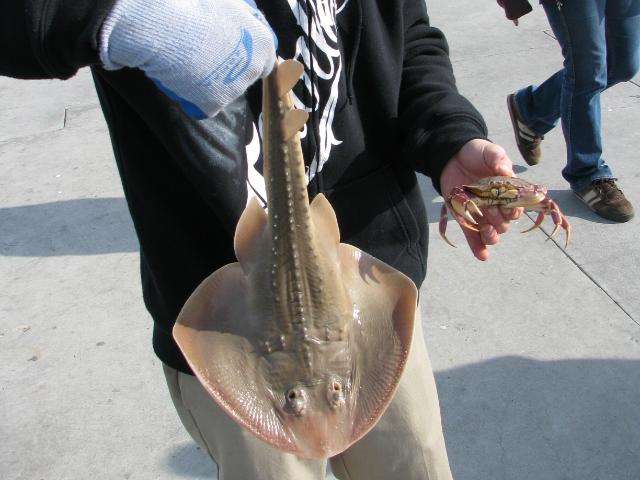
Typical-sized Thornback Ray aka Throw-Em-Back
Although the larger sharks are more common out at the end, an unusual run of thresher sharks did take place in the inshore surf area in September 1998—approximately 40 fish being spotted. The threshers would come up and slap baits with their tails, some were snagged, and four of the 30-80 pound fish were eventually landed.
Mid-Pier. A wide variety of fish are caught in the middle of the pier, almost all of the aforementioned shallow-water species (excepting corbina), some of the deep-water species, and some species most common to the moderate depths in this area.
Over the years one of the most common and dependable mid-pier fish has been tomcod (white croaker), a fish much despised by some and a fish given a plethora of names — tomcod (southern California), roncador (Ventura and Santa Barbara area), kingfish (central and northern California), sewer trout, tommy and brownie. It even seemed to somehow gain some (for probably less than flattering reasons) names connected with cities—Pasadena trout, Glendale trout, Santa Ana corbina. Oh the woes of being a tomcod! To make it worse, their numbers seem to be going down. Trips to this pier and others have seen fewer and fewer, as well as smaller and smaller, tommies and, for the first time, in 1998, a 10-fish limit was applied. Most tomcod are caught on high/lows with number 6-2 hooks, and cut anchovy or other fish such as mackerel. Although the old cast and wait procedure can work for a few fish, it’s better to keep the bait in motion. The tommies will often strike as the bait is settling down into the water and then a slow retrieve will entice the fish to hit. Signs normally warn against eating white croaker but the good news is that small tommies are excellent halibut bait (called brown bait).
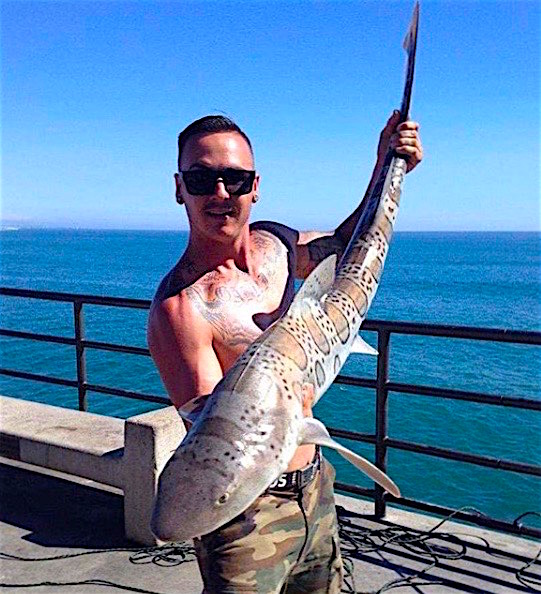
A Leopard Shark from the mid-pier area (photo courtesy of Let’s Go Fishing)
Herring (queenfish) are another common little croaker in the mid-pier area and will hit on strips of anchovy or be caught on Sabiki/Lucky Lura-type bait rigs. Typically they are at a mid-level in the water so drop the rig to the bottom and give some slow jerks upward. If you do not feel fish move the rig up a few feet and repeat the jigging motion. Continue to move the rig up until you find the fish.
A favorite fish that likes to feed on the queenfish is white seabass and a lively small queenfish used as a bait will sometimes result in the white seabass (usually the smaller fish called sea trout).
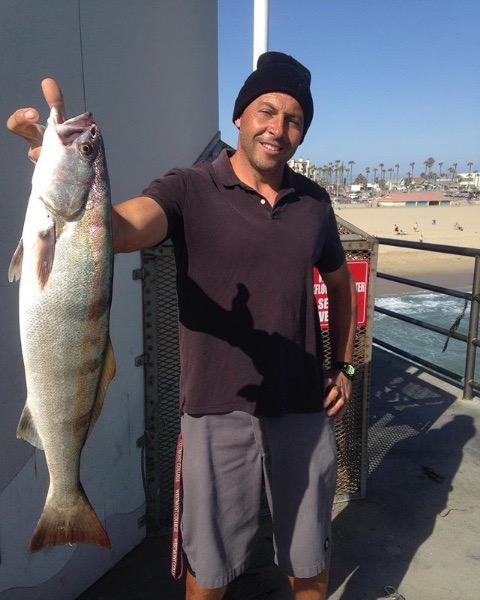
A White Seabass (Sea Trout) caught on a live smelt (photo courtesy of Let’s Go Fishing)
Another small fish, salema, a member of the “Grunt’ family, will also hit almost any bait as long as you’re fishing with small hooks and at mid-depth levels. Sometimes the schools of salema will be mixed with schools of queenfish. At other times salema will be found under schools of topsmelt and jacksmelt). A second member of the “Grunt” family is sargo which can be caught in the same area. Often mistaken for croaker and fighting like croaker, they can reach a good size.
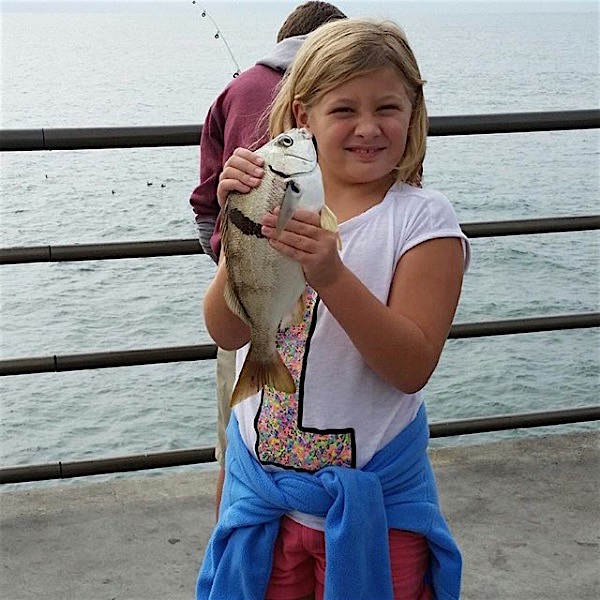
A Sargo (picture courtesy of Let’s Go Fishing)
Topsmelt and jacksmelt are usually caught on multi-hook bait rigs fished near the top of the water. The topsmelt can be snagged with size 10-12 unbaited hooks, the larger jacksmelt prefer size 8 hooks sweetened with a small piece of bait (seaworms, small pieces of shrimp, or strips of squid). The topsmelt are almost always at or near the top of the water, the jacksmelt will sometimes go down a few feet in the water.
A couple of unusual (for the pier) fish taken in the mid-pier area were a pair of striped bass taken near the Lifeguard Tower in November of 2016. What bait? Artificial Berkeley sand worms.
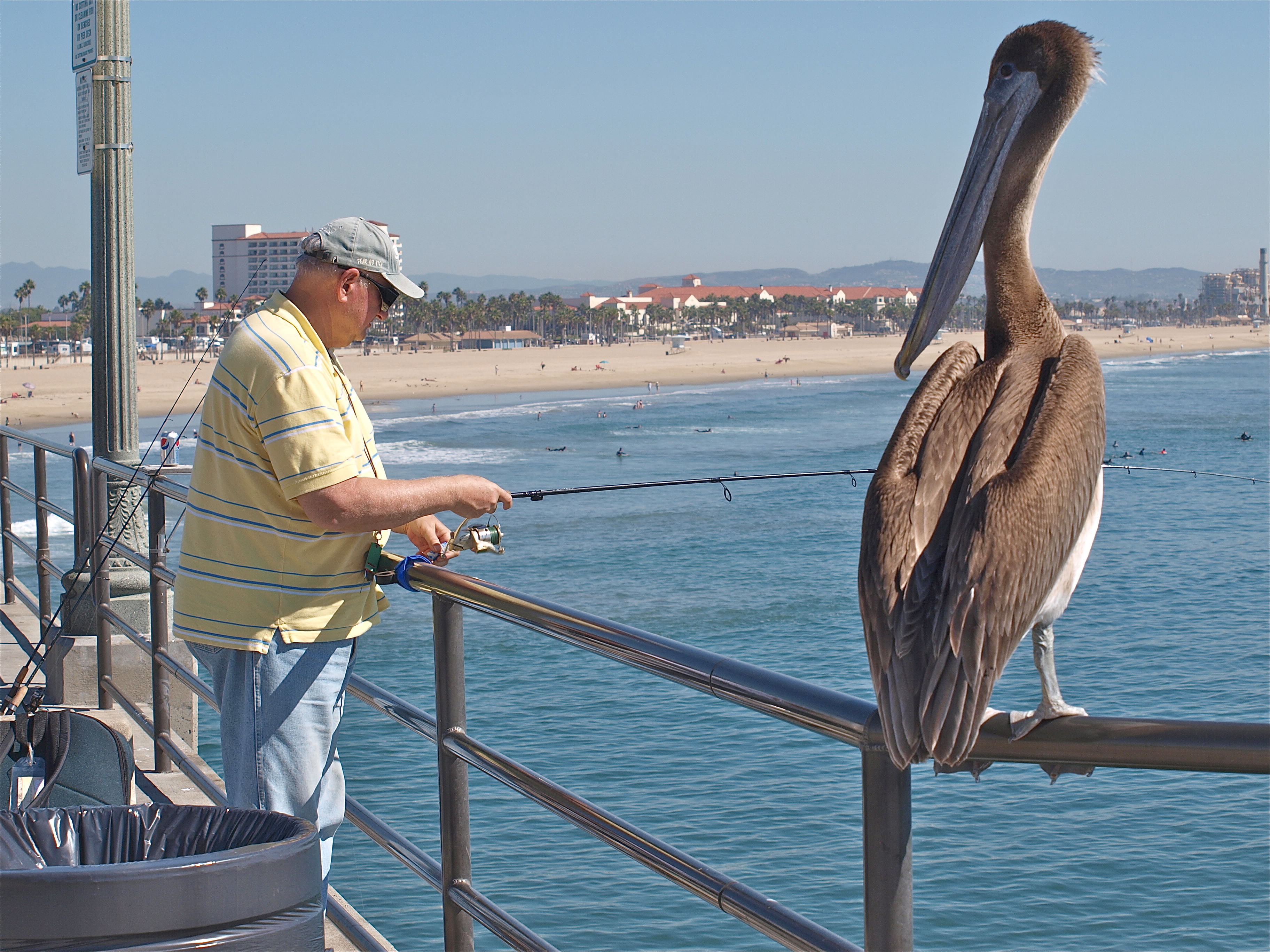
My fishing buddy Mike Granat and a new found friend waiting for some action
The mid-pier area is the favorite area for halibut although the flatties can show up almost anywhere from the surf area to the end. The halibut, being ambush predators, prefer a live bait fished on the bottom and here that usually means a small anchovy, smelt, perch, sardine or mackerel. Since live bait is no longer available at the pier, net or Sabiki-up some small fish and have some type of contraption (bucket, pail, sophisticated bait tank, etc. and an aerator to keep the bait live. I can’t give the increase in odds of catching a halibut of live bait versus dead bait but it’s much, much, much higher.
Live bait is usually used with the Carolina-type fish finder rig and remember that the depressions between the pilings are typically where many of the predator flatfish lie in wait for an unsuspecting fish to come swimming along. When they do the halibut make a very quick dash up to grab the fish (aka food). One technique that can be used IF the pier isn’t crowded is to troll your bait. Simply move your bait along the pier paying special attention to the areas between the pilings (and be ready for a strike).
If live bait is unavailable, the next best alternative is to have a moving lure, with locals taking quite a few of the hallies on lures, especially swim baits. A local favorite seems to be AA sized Cotee Lures (white and blue, white and green, clear silver and blue, or clear silver and green). Some flatties will also be taken on cut anchovy or mackerel, but not as many as the live bait.
Do remember the grunion runs! Halibut will often follow the grunion into the shallow waters and provide some hot fishing if you can time it right. As a general rule, most halibut are caught from mid-May until about October. By the way, the halibut do reach a pretty good size at the pier with a 37” fish being caught in January of ’02, a 37 ½-incher in May of the same year, a 49-inch fish in October 2004 (on a live sardine), a 36-inch fish in October 2007, and 37-inch and 38-inch hallies in September of 2008.
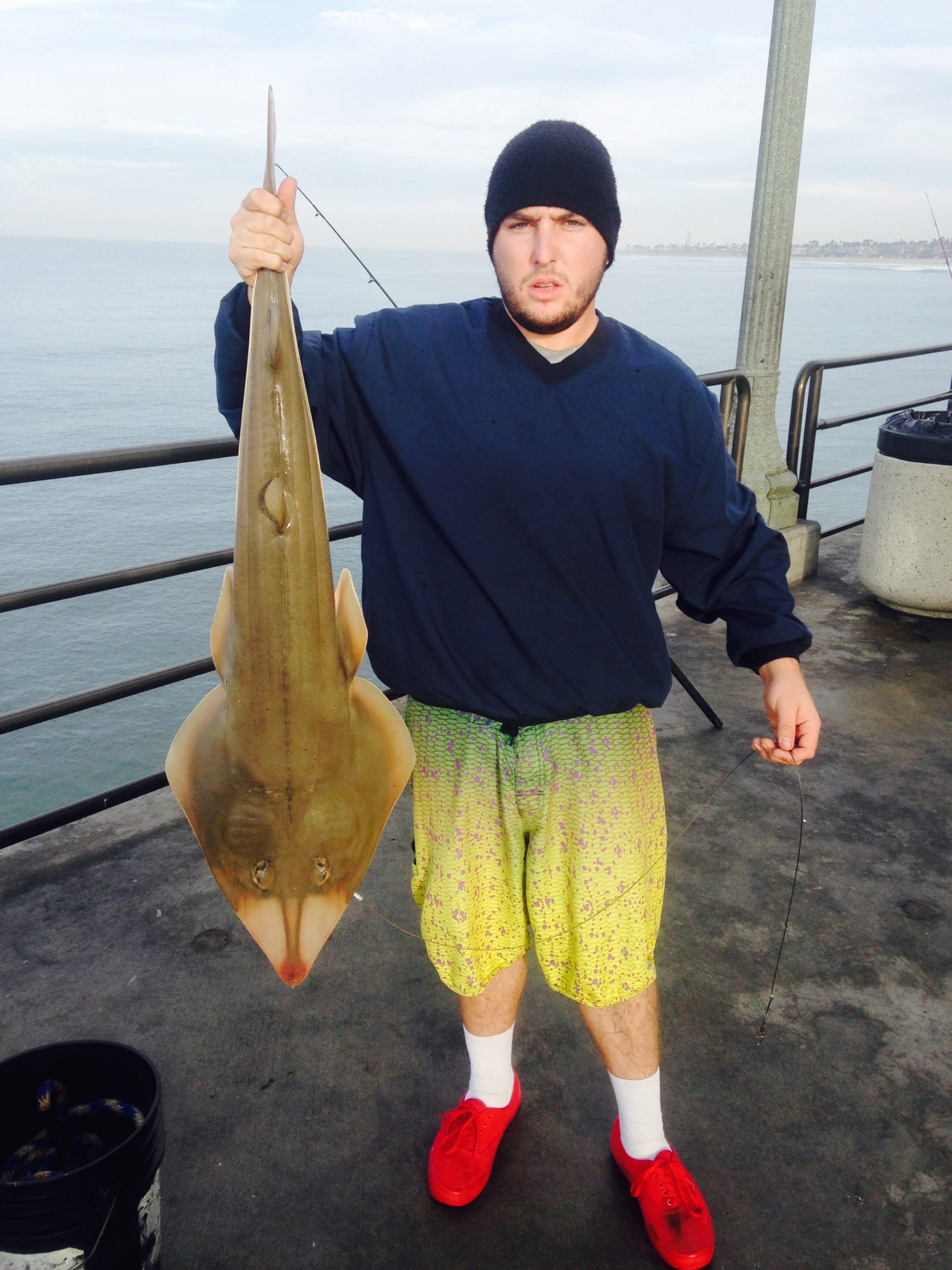
A mid-sized Shovelnose Guitarfish caught by Cody (photo courtesy of Let’s Go Fishing)
Another favorite in the mid-pier area is shovelnose sharks (guitarfish) and some of the guitarfish will reach an impressive size, nearly five foot in length. They are less discriminating then halibut when it comes to bait (although they also like live bait), but cut bait—anchovies, sardine, mackerel or pieces of squid are their normal preference. Use a high/low rigging or a fish finder rig with size 4-1/0 hooks and 20+ pound test line. An uncommon guitarfish, but one occasionally seen at SoCal piers, is the banded guitarfish and one was caught here in September 2018.
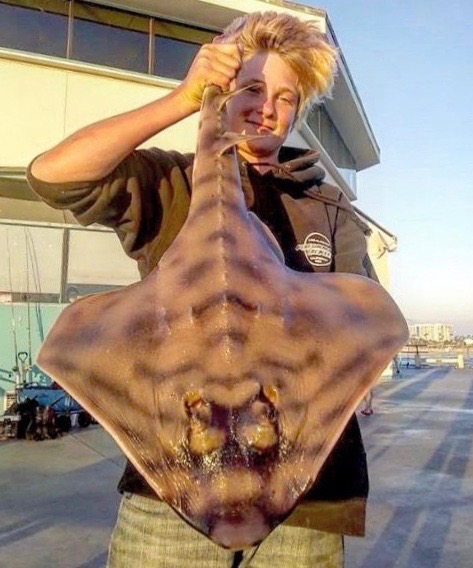
An uncommon Banded Guitarfish (photo courtesy of Let’s Go Fishing)
A third favorite, although less common, are bass, both barred sand bass and kelp bass (calico bass). There are occasional good runs of the barred sand bass while the calicos are usually more solitary (at least the larger ones) and sometimes there are good runs of these fish at the pier. Both are most often caught on anchovies fished at mid-depth levels.
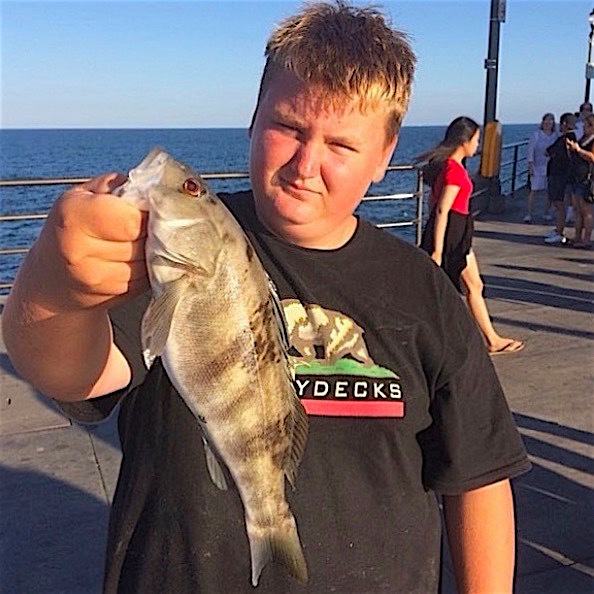
Barred Sand Bass (photo courtesy of Let’s Go Fishing)
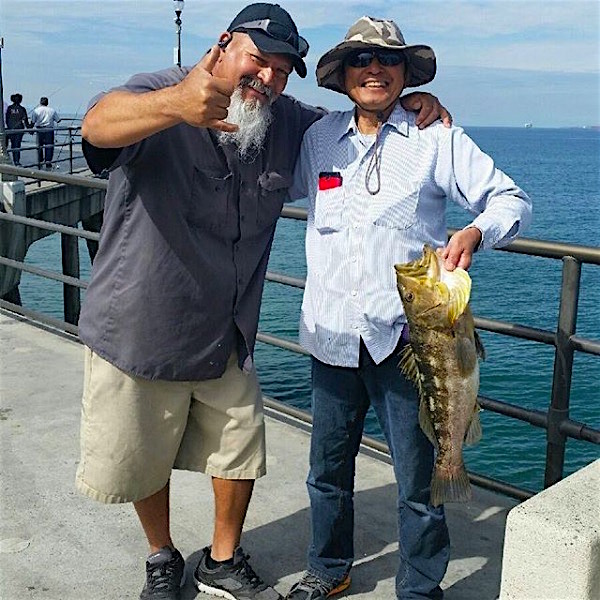
A nice Kelp Bass (Calico Bass) (photo courtesy of Let’s Go Fishing)
Of course two pelagic species cannot be ignored—Pacific mackerel and Pacific sardine. Although preferring the deeper waters at the end, they can sometimes seem to saturate the water all the way from mid-pier (or even shallower) to the end. Mackerel are seen pretty much every year while sardines go up and down in cycles with heavy numbers showing up for a few years then disappearing altogether for several year. Water temperatures and survival of the juvenile sardine appear to explain the cycles.
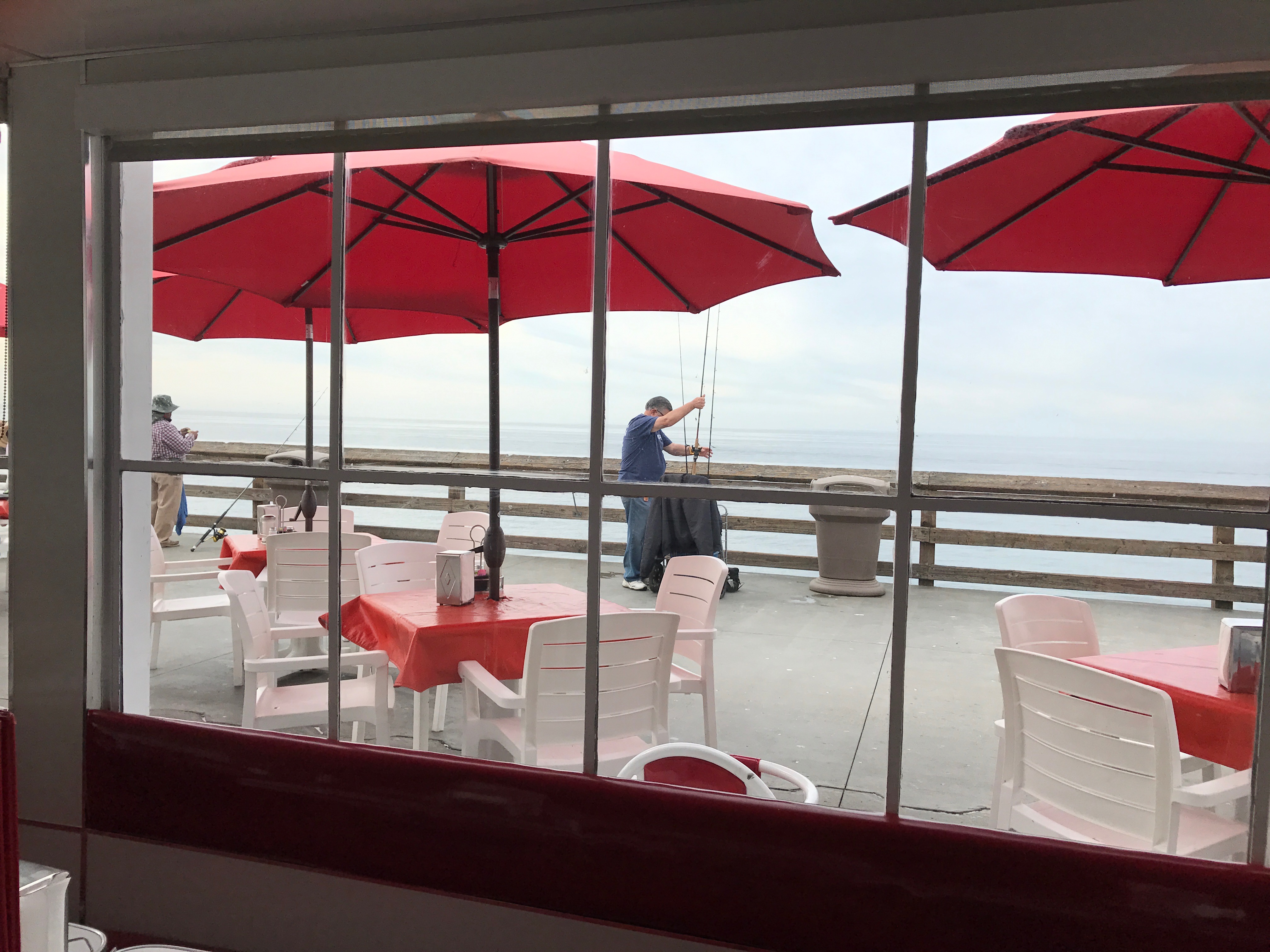
Getting ready to fish out at the end of the pier
End area. The end area is the main home for most of the pelagics and for the larger sharays. The most common pelagic species include Pacific mackerel, jack mackerel, Pacific sardine, and jacksmelt (to some degree), and the more infrequent species such as Pacific bonito, California barracuda and yellowtail. The most common sharays will be bat rays, guitarfish, leopard sharks, spiny dogfish and thresher sharks; they can be joined at times by soupfin sharks, 7-gill sharks and, once in a blue moon, more exotics like mako sharks or blue sharks.
For the small pelagics, the Pacific mackeral, jack mackerel, and sardine, the most common rig is a multi-hook bait rig, i.e., a Sabiki or Lucky Lura rig. When the fish are thick, the rig can simply be retrieved through the water without any bait and the fish will hit them. At times they are a little more fussy, even persnickety, they want some bait, and the best bait is typically small pieces of mackerel. Use a size 4 or 2 Lucky Lura or Sabiki leader with the bait. Keep the leader just under the surface of the water or cast it out and slowly retrieve it. If the mackerel are in a light-biting mode, switch from the bait rig to a single hook on your line with a split-shot or twist-on sinker a few feet up the line. This rigging is a little harder to use here than at piers close to the water but works fine if the wind and current aren’t too strong. If fishing at night, night lites will almost always help the bite.
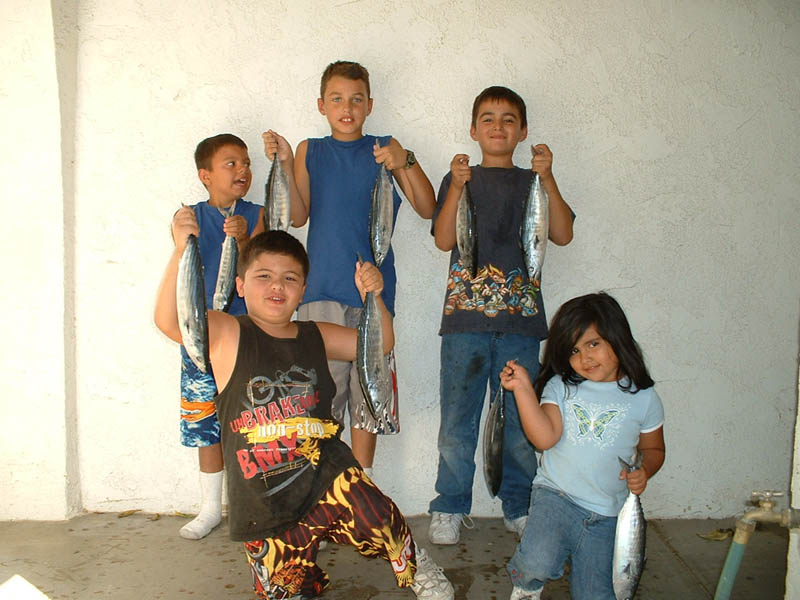
A number of bonito caught by the “Al Castillo Crew”
When bonito show up, usually during warm-water years, use a bonito feather trailing behind a Cast-a-Bubble. Or, simply use lures such as spoons (Krocodile or Kastmaster), MegaBaits, or the small Jigpara and Coltsniper lures that are increasingly popular. Usually the bonito will show up late summer to fall.
Summertime to fall should also see a few barracuda, especially at night. The best rigging for the barracuda is usually a 1 1/2-2 1/2-ounce silver or gold colored spoon (Kastmaster or Krocodile).
Although rarely a common catch, warm water years usually may also see a few yellowatail caught although they are mainly small “rat” or “firecracker”-size yellows. The warm-water year of 2015 saw quite a few of the small yellowtail caught. Most are caught on live bait.
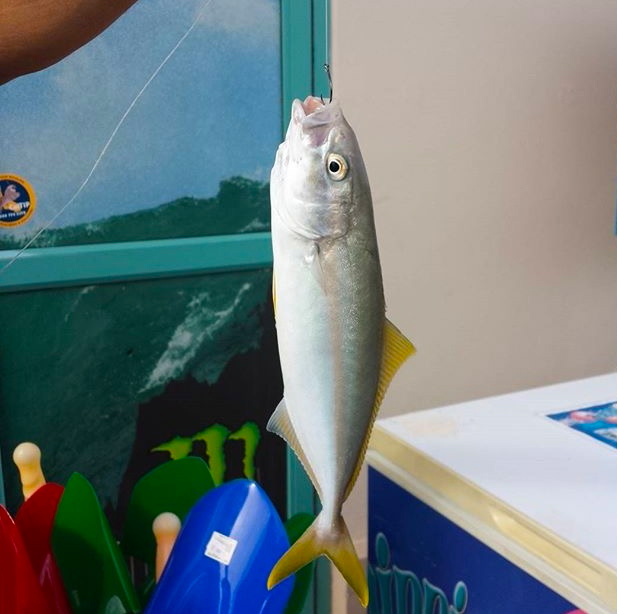
Firecracker-size yellowtail caught by Cody — 2015 (photo courtesy of Let’s Go Fishing)
The pier is noted for sharks and rays and most nights will see anglers trying for the sharays, especially the larger leopard sharks (to 4-5 feet in length), soupfin sharks (to six feet in length), and bat rays. Most seem to be taken out toward the end of the pier and (in my visits) most often at the northwest corner. Daytime too sees anglers fishing for sharks, especially thresher sharks (to 9 feet in length) since they seem to be more commonly caught during the day.
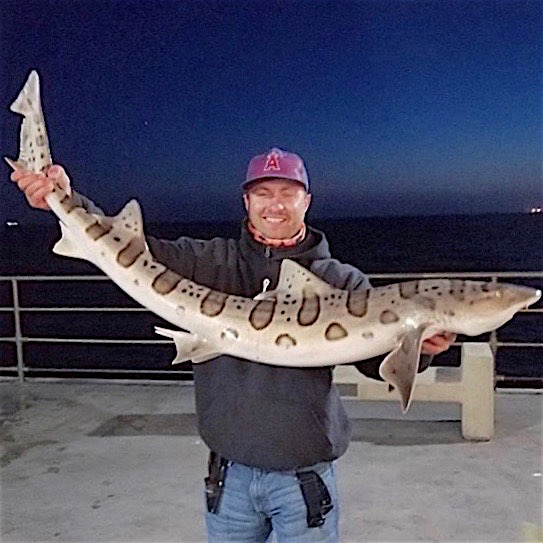
A nice-sized Leopard Shark taken by Chris (photo courtesy of Let’s Go Fishing)
The pier is noted for both the number and size of its bat rays (including the state record fish) and these rays, aka “mud marlin” for their fighting ability, have made some pretty interesting runs at the pier. One run occurred at the pier in April of ’99 when a number of large batties were caught. One angler alone, Greg Taite, caught 12 bat rays over 50 pounds in one five-hour period, two of which weighed about one hundred pounds each. A few days later he returned and in a short time hooked and landed a bat ray estimated to weigh 125 pounds. He used 40/50 pound test line, a 5/0 hook, and the same bait for all—squid.
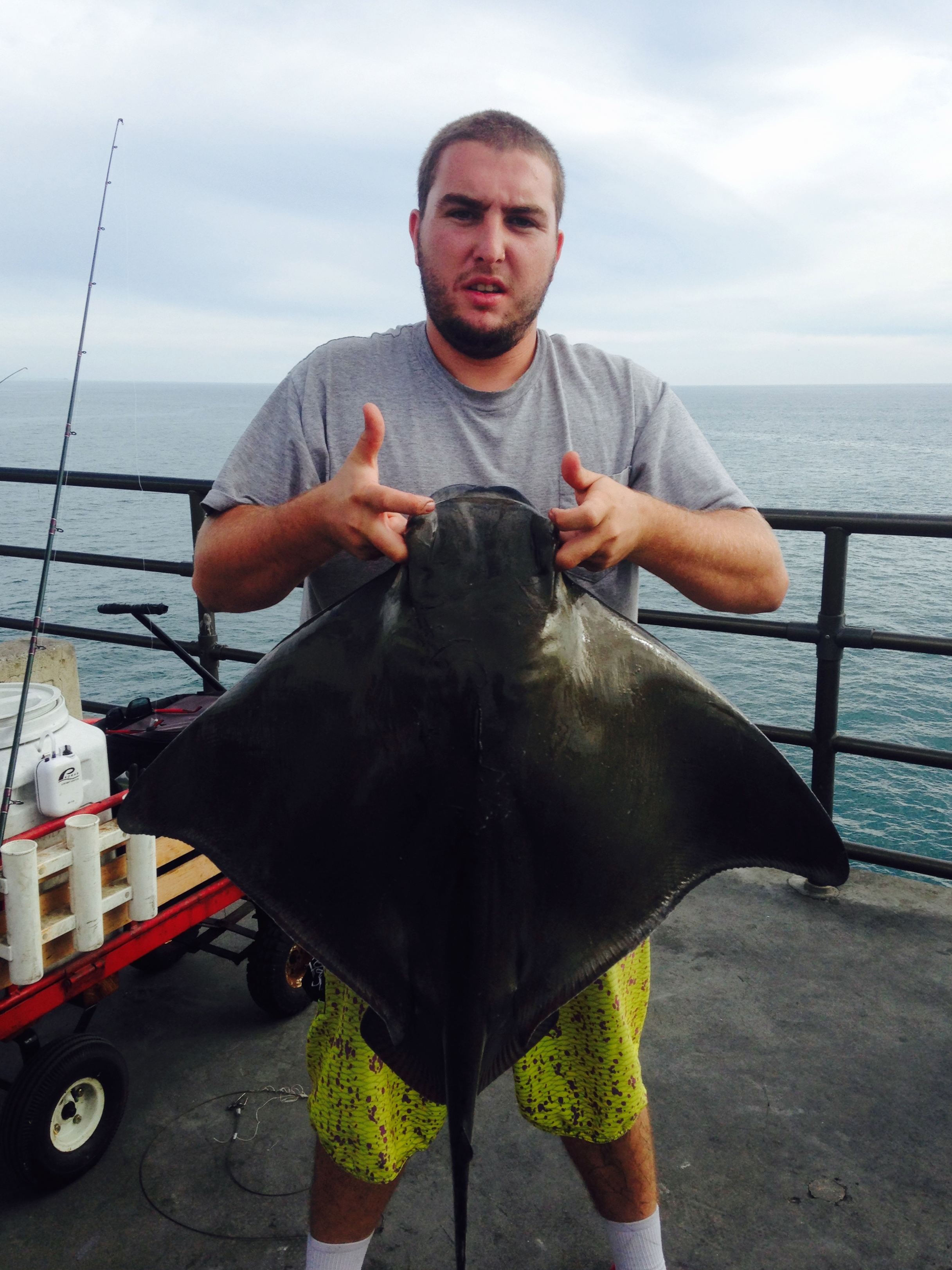
A medium-sized bat ray (that should be held by its mouth) — photo courtesy of Let’s Go Fishing
Many rays exceeding 100 pounds in size have been caught here (including a 123-pounder by Robert Gerber in March of ’99). A huge bat ray, estimated by locals to be over 200-pounds was taken the first week of December of 2009. The huge fish required the combined strength of seven anglers to haul it up to the pier where a picture was taken. However, with the bait and tackle shop being remodeled — and closed, the ray was never weighed. If the locals were right, it would have been a new state record bat ray. Another huge battie, guesstimated weight 200-pounds, was taken in May of 2014. Don’t know if either fish were actually record fish but there certainly some big bat rays taken at the pier and, the state record bat ray was caught at Huntington Beach in July 1978, a 181-lb, 0 oz bat ray.
Several runs of thresher sharks have also taken place, most out toward the end of the pier. August ’99 saw a run lasting for several weeks with some days seeing ten or more of the six-foot and up sharks being hooked on the live bait (mackerel or sardines) and sliding leader rigging. The standard set-up was 50+pound mono line, a 6-12 ounce sinker, and a 6-foot sliding wire leader with 8/0-9/0 hooks. A long cast from the pier was followed by sliding the bait down to the water that hopefully produced lively looking bait that would attract the long-tailed sharks. A similar though shorter run of the threshers took place in May ’09 with a 125-pound fish being the largest that was actually landed. Unfortunately one pier visitor wasn’t too happy to see a thresher on the pier and actually called the Humane Society with complaint. His complaint was ignored.
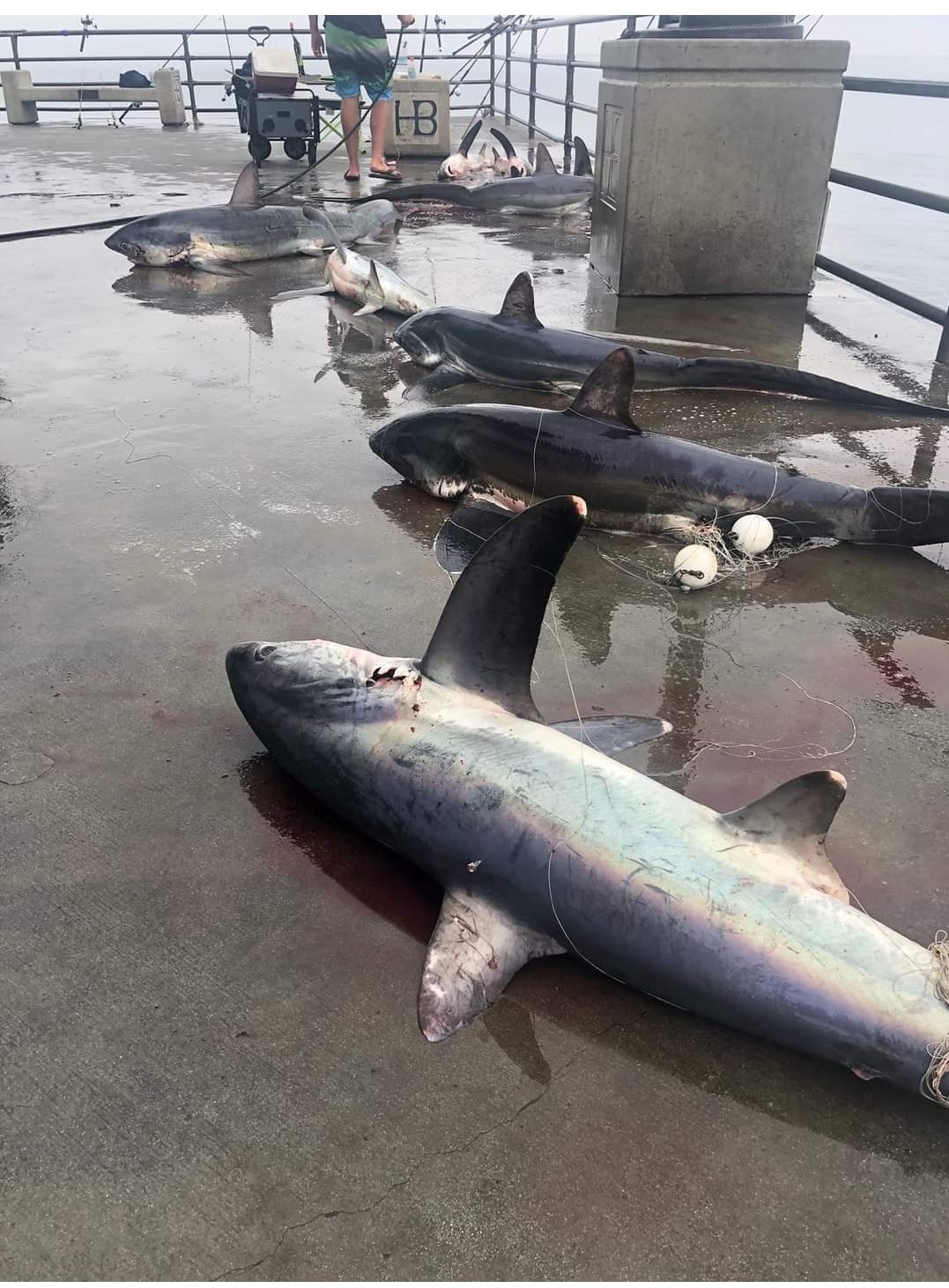
Thresher Sharks in September 2020
That same year, 2009, saw a one-day, mini-run in August when twelve threshers were hooked with four landed. Interestingly it was the same day as an earthquake in Baja. Waters around the pier were filled with sea lions, dolphins, and, apparently, threshers. Some speculated that the assemblage of sea creatures was due to the earthquake to the south; I’m guessing there was probably simply a good number of baitfish in the area. But who knows? Just a few days before that scene an 8-foot-long thresher had been landed, two weeks later a 9-footer was landed.
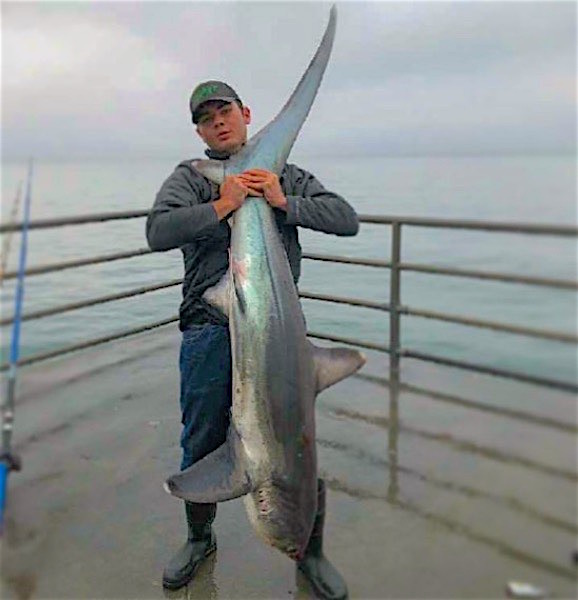
Thresher Shark caught by Joe (photo courtesy of Let’s Go Fishing)
Many other sharks have made appearances at the pier. A short run of soupfin sharks took place in August of 2002 when several were landed, the largest one a six-foot-long, 65-pound fish. November 2016 saw the catch of an 80-pound soupfin. A six-foot-long 7-gill shark was reported in July 2016. A 35-pound, 39-inch horn shark was taken in June 2005; another large horn shark was caught in September 2018. A 5-foot-long blue shark estimated to weigh 75 pounds was take in July of 2005.
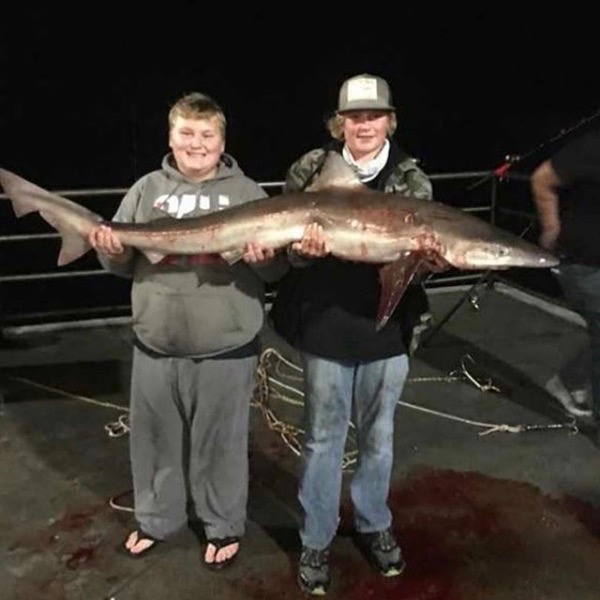
Soupfin Shark (photo courtesy of Let’s Go Fishing)
Be sure if you’re going to seek out the sharks to have a hoop net with you and, hopefully, someone to help you land your fish. I do not recommend using a pier gaff any longer UNLESS you are sure you will keep the fish to eat. Large thresher sharks are easier to gaff than net. The same with large bat rays but only gaff them if you intend to save them and eat them.
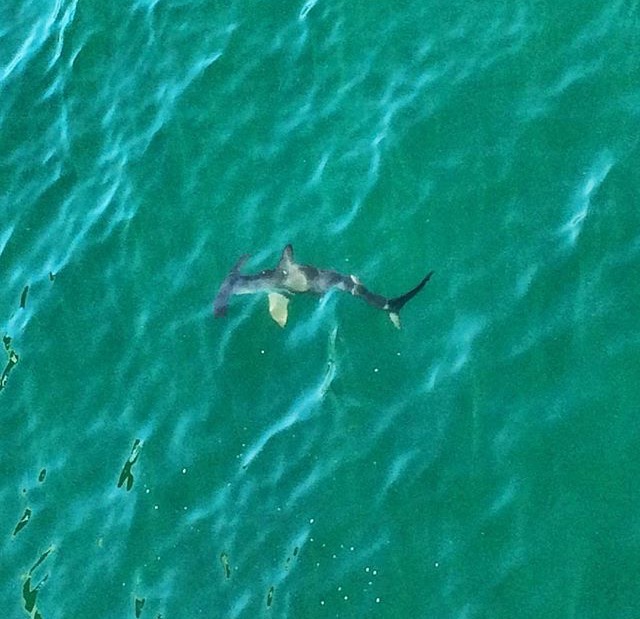
Hammerhead Shark (photo courtesy of Let’s Go Fishing)
During the warm-water El Nino years, several hammerhead sharks have been spotted swimming near the pier and in June of 2004 a small hammerhead was caught, a fish estimated to weigh 50-60 pounds.
An illegal to take shark that has shown in up increasing numbers the past decade is the great white shark (aka man-eater shark). The first reported to PFIC was one taken in August of 2011. When the young angler posted the picture on YouTube of the landing and subsequent parade around the pier with the small, 5-foot-long, bloodied fish, it was sure to attract the attention of the Fish and Game who tracked him down. Since then quite a few great whites have been seen at the pier and several great whites apparently have been taken, usually to adverse publicity and charges. September 2016 saw the report of an estimated 250-pound great white grabbing a piece of bonito but that shark broke off after reaching the top of the water. Remember that it’s illegal to target and/or to keep great white sharks. If one is hooked, cut the line before bringing the shark up to the pier — or risk a BIG fine.
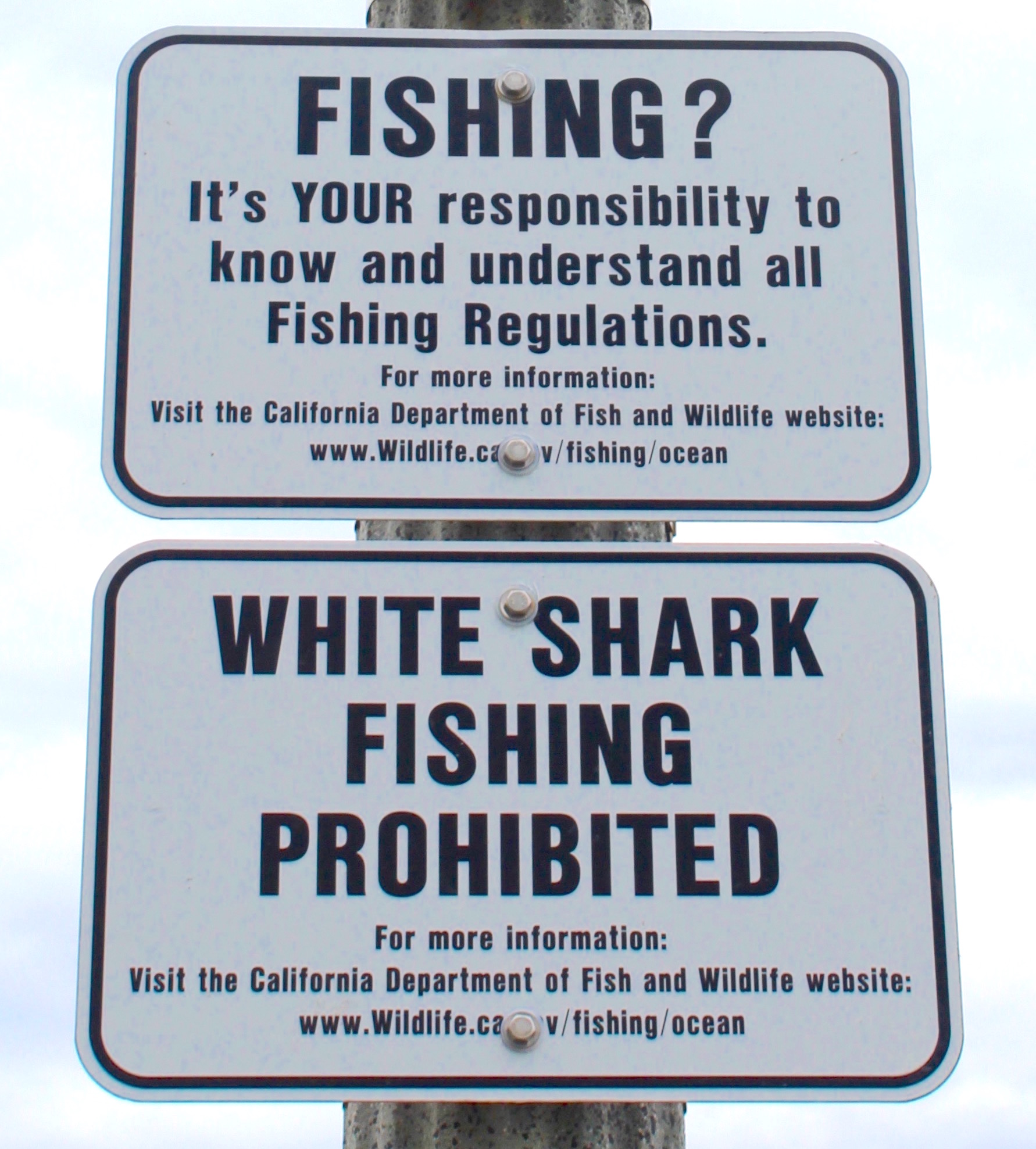
Of course there are times when the unexpected show up. An unusual catch in February of ’02 was a two-foot-long silver salmon, a now illegal to keep species that was mistakenly kept and taken home by the angler (could have been a big fine.) An almost identical catch of another silver was made in June of ’08 and once again the fish was kept. It followed by two days the catch of a 30-pound or so illegal giant sea bass that was hoisted up onto the pier. By the time the pictures were taken and all the pomp and circumstances were over, including lowering the fish back down into the water where it floated before being snagged and dragged back up onto the pier, it was dead. More and more of the giant (black) sea bass are showing at the pier and it’s hoped that they will be returned unharmed to the sea.
Crustaceans and Other Beasts. Given the sandy-shore environment at the pier, Huntington Beach isn’t known as a good pier for crustaceans, either crabs or spiny lobsters. However, that doesn’t mean they aren’t taken. Most of the crabs will be gnarly-looking spider crabs, some of which pretty respectable size.
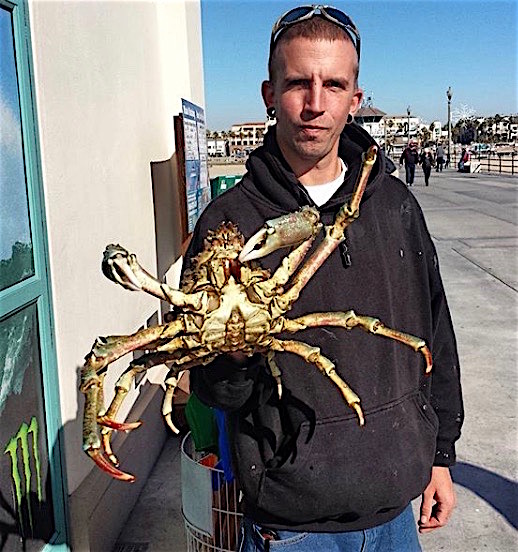
Spider Crab (picture courtesy of Let’s Go Fishing)
Spiny lobster also show up. A large 10-12 pound lobster was taken in September 2003 and an even larger “bug” was taken in 2013 when a 17-pounder was captured by a diver, Joseph Ali, who was diving down around the pilings at night. So, some big ‘uns are there.
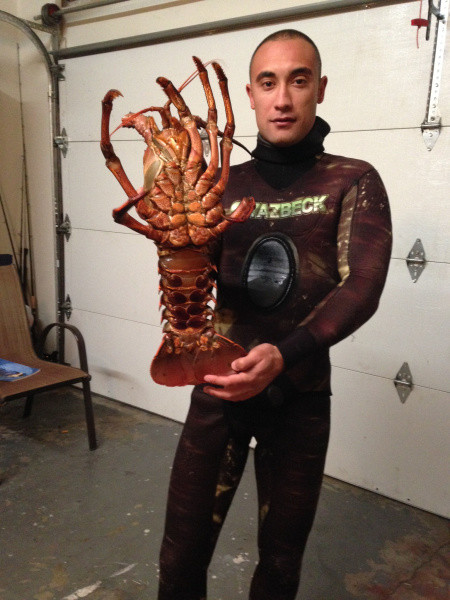
Although not as common as at Newport and Balboa, occasional flurries of action will be seen from the large Humboldt squid when they invade SoCal waters. August 2002 and May 2007 saw the squirming and squirting squid invade local waters and saw squid up to four feet in length landed.
The Pier Rats Speak
Date: November 25, 1999
To: Pier Fishing in California Message Board
From: Quik2
Subject: Shark attack at Huntington Beach Pier!!!! 11/24/99
Lots of Sharks at Huntington Pier. Lots of bites, lots of action. We caught over 12 fish, got over 20 bites and two broke our lines really fast. My roommate started the day catching a 2.5 ft mako shark, then I hooked on to a 2.5 ft gray smoothhound. 30 seconds after my hit, my roommate hooked on to a 3 ft smoothhound. All were huge, from 7-15-lbs at least (we had no measuring scale). Anyway, had about 8 thornback rays, really big ones too. Also caught a kingfish, and one bullhead. One shark hit my pole and my reel went zee zee zee. Then I tried to set the hook and snap, I heard 20-lb test snap in 2 sec. I didn’t even flip my switch to on yet on my Sealine reel. I think it chewed through the line… then my roommate also lost his line too. It was a great night, lots of big sharks swimming around. I did a really stupid thing because there was a hook stuck down in the mako shark’s throat and we were using live bait hooks. So, I tried to get it out, with my roommate holding the jaw and it’s mouth, but I accidentally hit my thumb on his mouth and got a … (censored) thumb bleed. For 15 minutes it was like dripping out. Had no Band Aid so I just put a napkin on it and tied it with a 40-lb test fishing line. I had it like that for 20 minutes before I ran into Ruby’s and asked them for a Band Aid because it wouldn’t stop bleeding. Luckily they had one. I felt pretty stupid, cause the teeth don’t look sharp. They looked like teeth on thornback rays. Plus, I’ve never caught such a big shark. Most of the ones I caught at Berkeley Pier in the S.F. Bay Area are mostly 1 ft. and they don’t have much teeth. But this one tore me up. Anyway, it was a great night; all we used was squid. We never got to sit down for more than 10 minutes except the last 30 minutes. We fished 9-12 p.m. Pretty good night!
To: Quik; From: Snookie
Dear Quik, Sounds like you had a great time. As to a mako shark, look up a picture of one. If yours was a mako, it was a newborn baby, and even at that makos usually don’t wander that close to shore here, even to have their young. It is certainly of interest if your shark was a mako. That means there is a big mama around. Hope your next trip is as fun as the last one. Snookie
To: Snookie; From: Quik
Went Friday and Saturday night! Lots of sand sharks or what the DFG website called a spiny dogfish. Up to 4′ and over 20lbs. Between me and my roommate we lost over 6 sharks over 3′ in 3 nights because we didn’t bring our crab net. So Sunday we brought our net. We caught one that was 3.5′ and over 15-lbs — didn’t have a scale. A 36,” a 35,” and some others that we didn’t measure. Got it all on camera though. We had over 20 bites last night from 7:30 pm-12pm. Landed around 8 fish; 6 sharks and 2 thornback rays. Snookie that first one we caught was definitely a mako, all others that follow were sand sharks. People who helped us pull the line to land the fish on to the pier also ID it as a mako; too bad we didn’t bring our camera. It was a baby though, only 2′ long, about 8-lbs I assume; cut my thumb trying to get da hook out. Damn thing still stings as I am typing. People left and right of us also landed sharks. Lots of People there last night, probably more people tonight. I think this will be our last night until my roommate gets done with finals plus there are way too many people now. For the past three weeks no one ever fished the end where Ruby’s is. Now that we started catching sharks there at tons of people, especially kids trying to catch a shark. One kid cast over all four of our poles which gets us pretty upset. We have lots of fillet white meat in da fridge which will last us at least 2 weeks, we kept three of the biggest we caught and tossed almost all back; gave 2 away. I’ve never seen so many sharks caught on a pier in my life, at least not in the 3′ range. I often caught 1-2′ sharks at Berkeley Pier but those 3′ and beyond are rare for me so that got me and my roommate excited. Too bad they don’t fight too hard, they mostly jerk left and right trying to free themselves, instead of a tug of war fight. Oh well. I hope you guys go our and see it for yourselves, got between 7 pm-12 pm and use big chunks of squid. It’s almost guaranteed you will get sharks. It was pretty fun catching three 3′ sharks on my 6′ trout pole, and a Daiwa Jupiter reel. hehehehe seems like I am catching a whale on it. lucky we had a net. We now call it the little trout pole that could. BTW are there a size limit on these sharks or any sharks, except leopard sharks? BTW keep your catches away from sight, lots of pi…. off people these three nights talking about how sad it is for those sharks, and how crude we fishermans are. Hehehe, luckily for us last night we gave ours away or tossed them back. The guys to the left and right of us received some really nasty comments from people walking around the pier. I wonder if they also felt sorry for the chicken and that cow they ate for dinner or maybe that Thanksgiving turkey. Hummm there’s something they could think about.
To: Quik; From: Snookie
Dear Quik, Glad to hear it was a Mako. Interesting! As to size limits, the leopard is the only one so far with a size limit. Keep watching though as DFG is still thinking about more size limits on some other sharks such as the mako. Keep up the fun fishing. Snookie
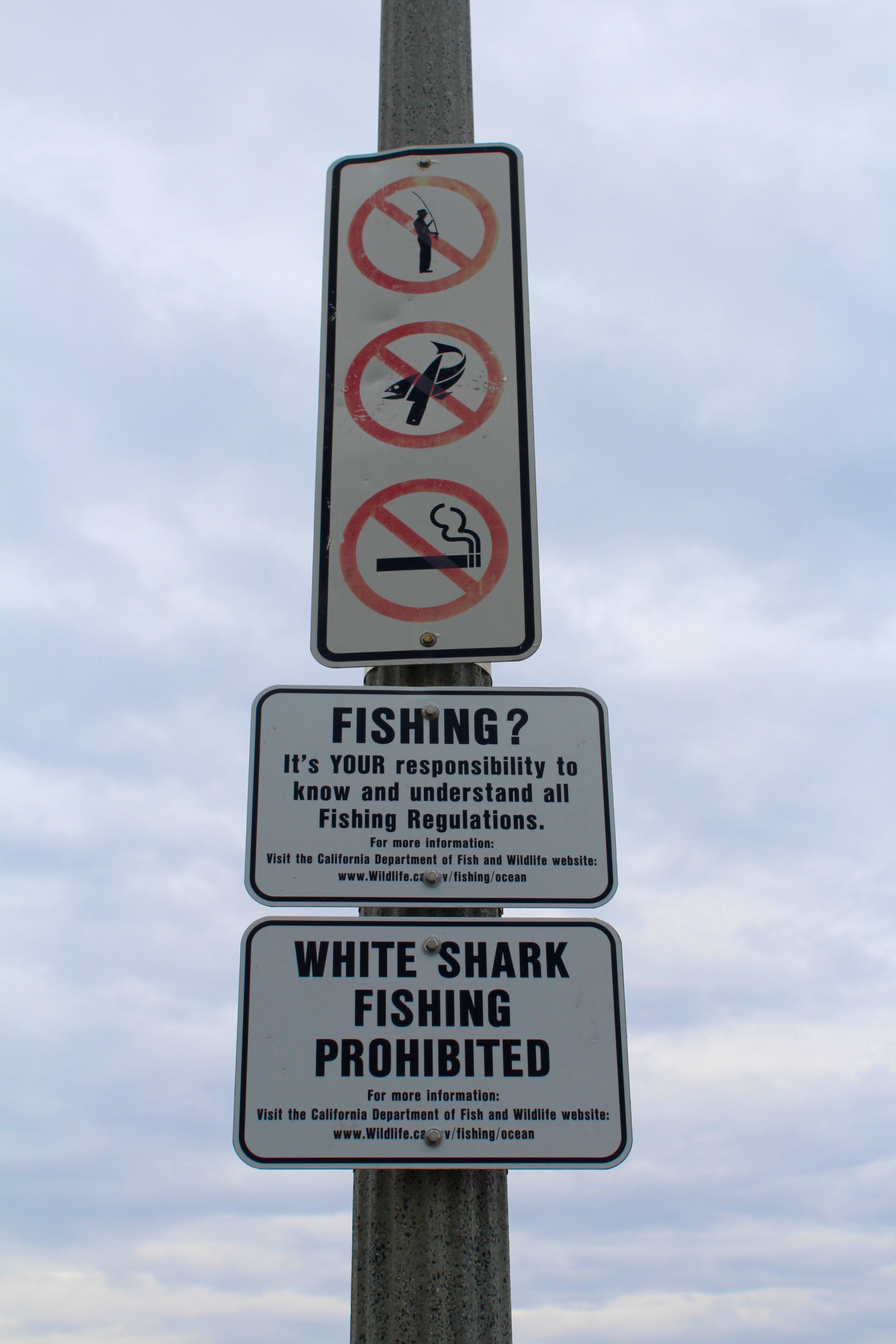
Date: July 2, 2007; To: PFIC Message Board; From: JohnG; Subject: HB pier + Zebra Perch Poachers !
Ken mentioned the Zebra Perch on the Huntington Beach pier report. So that brings up a rant. Well, I saw them Saturday. What an amazing site, a bait ball 30+ feet in diameter, solid with foot long Zebra Perch. Another amazing site were anglers (so called) snagging fish one after another, running up and down the rail, with total disregard for others (like me). Some even mentioned the term foul hooked. What a bunch of poachers! Buckets of fish came up. Next time I call Cal-Tip. PERIOD. On to better thoughts. The fishing was a bit slow. I usually fish Bass, and Halibut at night, because that is the only time I can, so I was really excited to fish during the daytime. I hit the pier at 5am to find very little bait, and very little action over all. Picked up a nice Spotted Sand Bass on the plastics, and a couple micro Butt’s. I also got spooled by a Bat Ray, I’d have to guess, on my 20# Newell rig. Nice day of fishing, I went home after watching the poachers. Sorry about the rant.
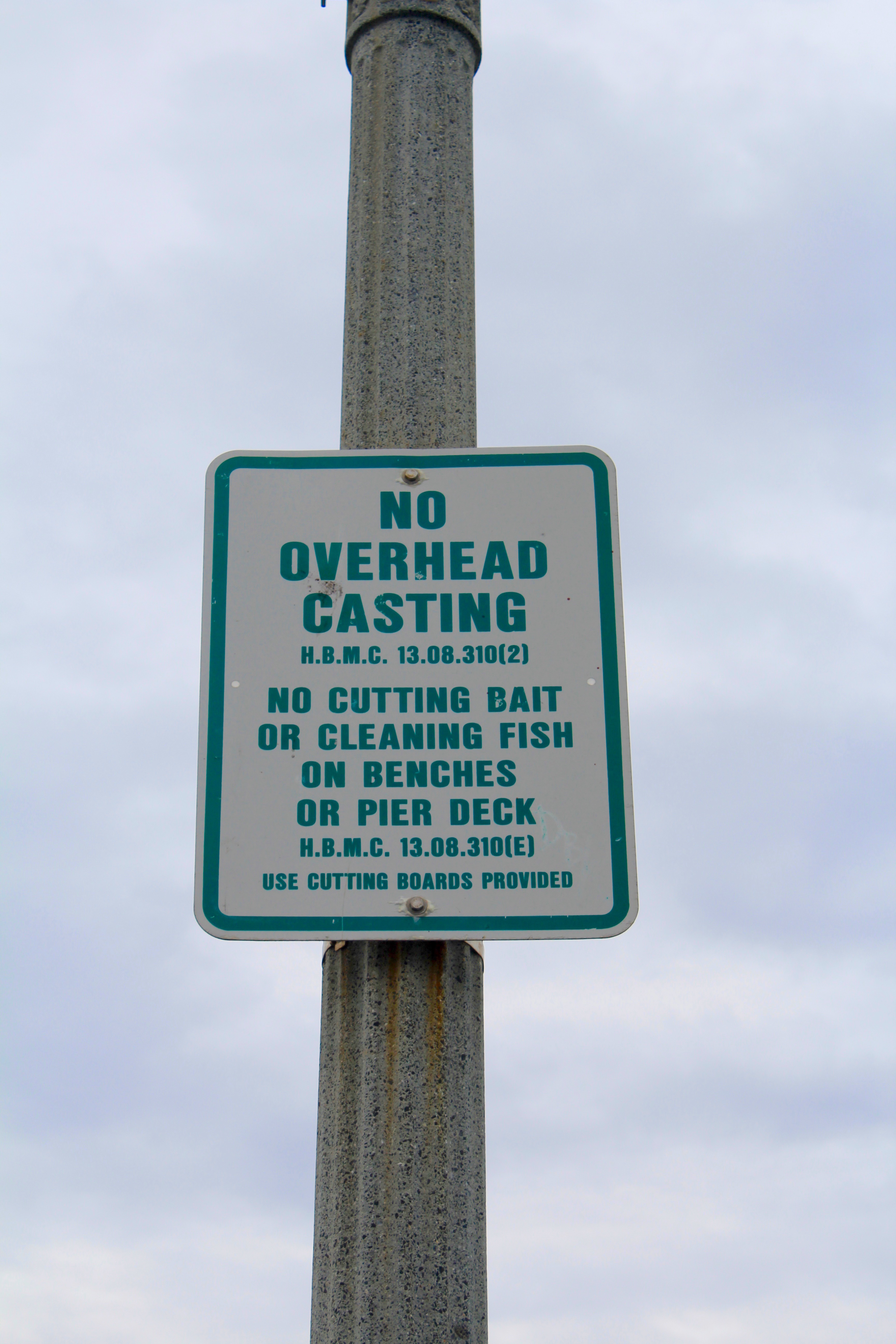
Date: June 6, 2008; To: PFIC Message Board; From: fission machine; Subject: Black Sea Bass & Salmon at HB
Yep, in the span of three days at the HB pier, two different people caught these two species. The first (which is posted on another site right) stirred up controversy in an argument over returning the fish to the water. These “people” caught a black sea bass and hoop netted it up onto the deck. The following argument from several anglers telling them to release it — got to the point of the authorities being called. On top of that the knuckleheads screwed around for so long that – you guessed it – the fish was dead by the time it landed back in the water. The other incident happened two days later, and involved a couple, who while bait jigging for mackerel, had hooked a Silver Salmon. The fish was hoop netted over the rail, and was fairly tweaked after being wrapped in the multi hook Sabiki rig. Funny thing was, the people wasted no time, wrapped up the fish with their load of mackerel, and bailed off of the pier within minutes. The only thing missing from this week could have been a great white or a cow cod (which would make for a trifecta)!?!?!? I generally will tell people at least once not to take verboten species but as many will tell you now some of the riff raff that comes down to fish at the piers now are armed, and or fresh out of prison, etc. I recommend not pushing your luck too far, especially at the LB or Seal Beach pier, but it is getting to where HB, Newport or Balboa can also be not as safe as in the good old days… The day after the salmon walked off of the pier, I drove by there on the way home from work, and a day late and a dollar short was your friendly neighborhood DFG agent…
Posted by pierhead
Don’t be too quick to tell them the fish is illegal — act like an admiring tourist and have them pose for a picture with the fish. Then follow them off the pier and get their car’s license plate. With that info the DFG can get their home address and make a follow-up contact. Remember — ignorance of the law is no excuse. Starting a confrontation on the pier doesn’t always result in saving the fish. Best to be safe and let the DFG follow-up. The resulting publicity will save more fish in the long run.
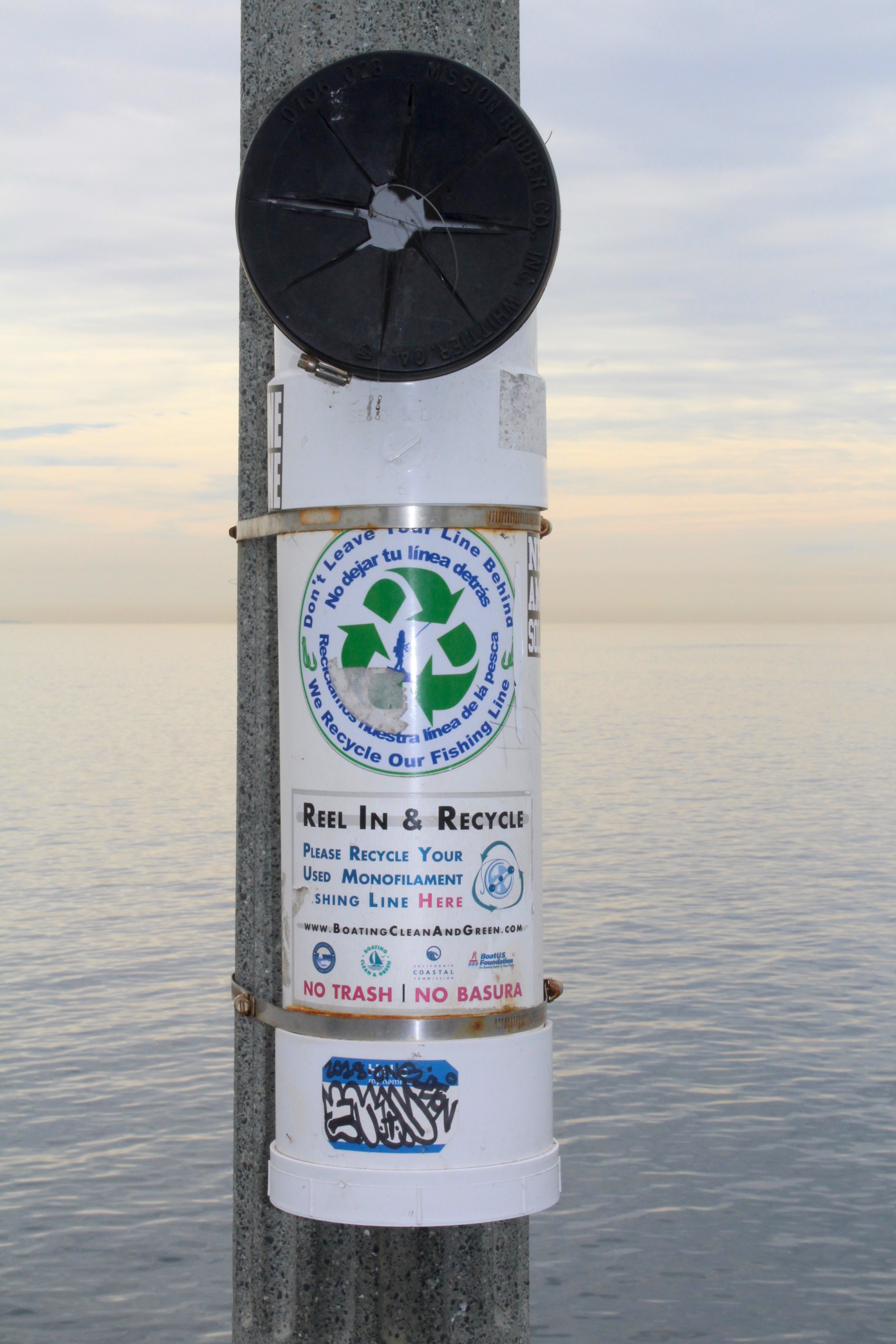
Potpourri — Perhaps More Than You Want To Know About The Huntington Beach Pier
<*}}}}}}}}}>< — When it was decided to rebuild the pier in the early 1990s, the question came up as to what to do with the old material. Why not use the concrete to construct an artificial reef in this relatively rock-free stretch of coast? Plans were made to do just that but they couldn’t be carried out. Once the cutting of the structure began, it was determined by the Fish & Game that the concrete was simply too old to be used for a reef — it simply turned into powder as it was cut.
Unfortunately, after spending several million dollars to rebuild the pier, the pier had (and still has) some serious deficiencies. Very frustrating are the railings that are made of anodized aluminum. They look nice but are very slippery and do not provide an adequate support for fishing rods. Most rods simply slide down the railing and wind up falling to the deck. One solution is to bring a couple of pieces of rope or a couple of towels. Tie them to the railing and place your rods between them. I’ve noticed that some regulars have designed their own rod holders, and they work, but that still leaves most anglers wondering what to do.
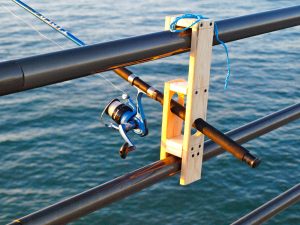
Homemade rod holder — one solution to the problem with the railings.
Another, even more frustrating mistake was a lack of bait cutting boards. There was really no places to cut your bait other than the fish cleaning stations and they were few in number. Since it is against the law to cut your bait directly on the deck (and you risked a very real $600 fine), the bait shop offered pieces of cardboard to put under your bait. Often these pieces of cardboard seemed to wind up in the water. What to do? I would generally fish right next to a cleaning station and cut my bait there. But, that is an impractical solution for most anglers. Next best thought was to bring along some newspaper upon which you could cut your bait. Hopefully, people would put the paper in the trash can when they left. The good news is that a visit in early 2018 showed that the city has responded to the problem (good job!).
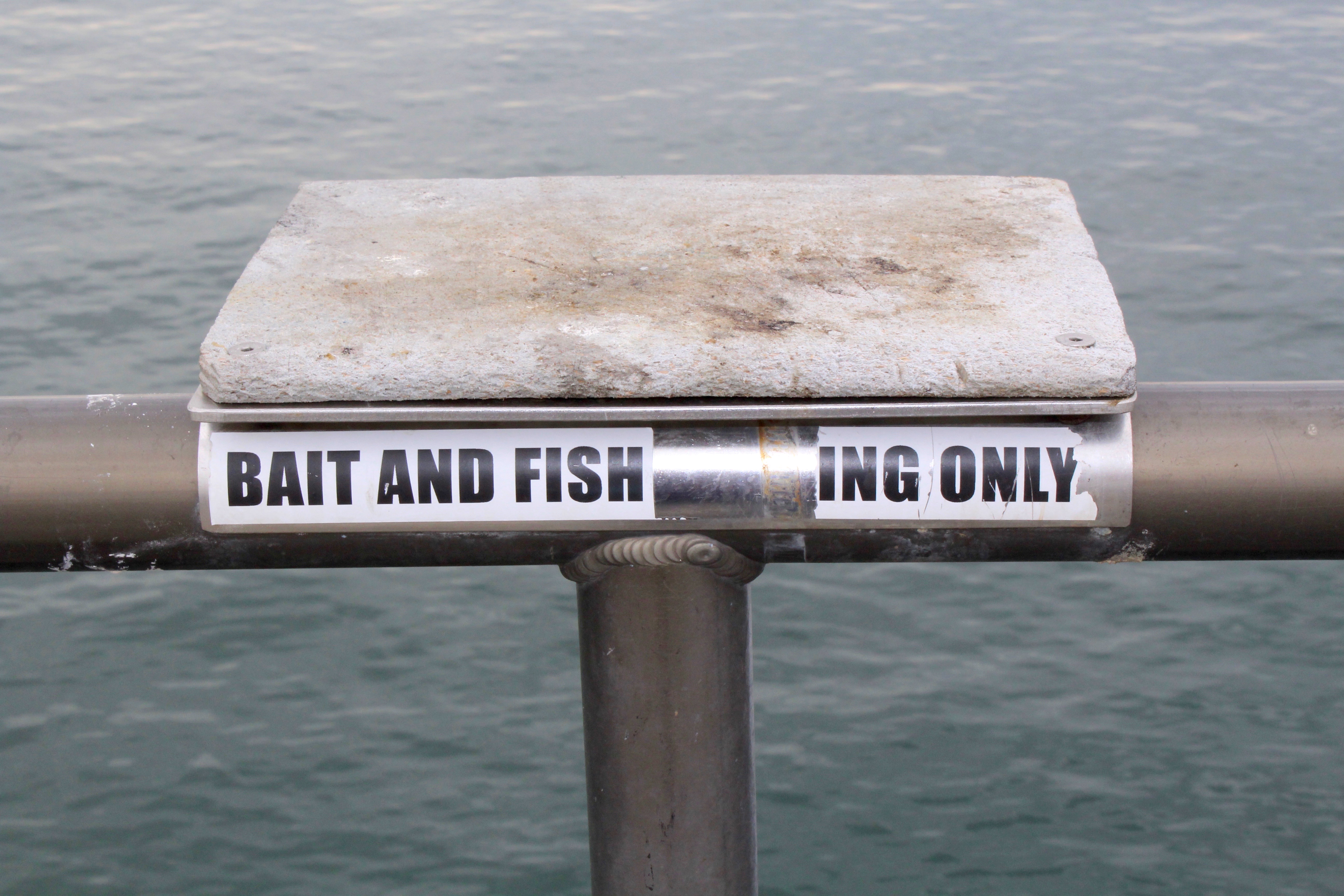
There are also very few benches! I hate to say this, but I wonder if the needs of the fishermen were considered as important as the pier looking nice for the tourists.
One thing the city has done right is sponsor a yearly “Huck Finn Fishing Derby.” The kid’s fishing contest normally has three divisions, age 7 and under, 8-11, and 12-15, with many prizes awarded for the biggest fish and best dressed young anglers. It’s a program that others cities should copy.
<*}}}}}}}}}>< — Two record fish are recorded from Huntington Beach. (1) The first was caught at the pier and is both the state and world record (IGFA) fish. The fish was an 181-pound 0-ounce bat ray taken at the pier on July 24, 1978 by Bradley A. Dew, a senior at Huntington Beach High School. Records indicate it was 23 pounds over the prior record and, according to the Dept. of Fish and Game, the fish had a 5 1/2-foot-wingspan, a 3-inch-long stinger, and the width across the bat ray’s eyes was an even ten inches. (2) The second is a fish recorded from Huntington Beach but no specific location is given. It was a 5-lb 8-oz mackerel jack taken on September 1, 1988.
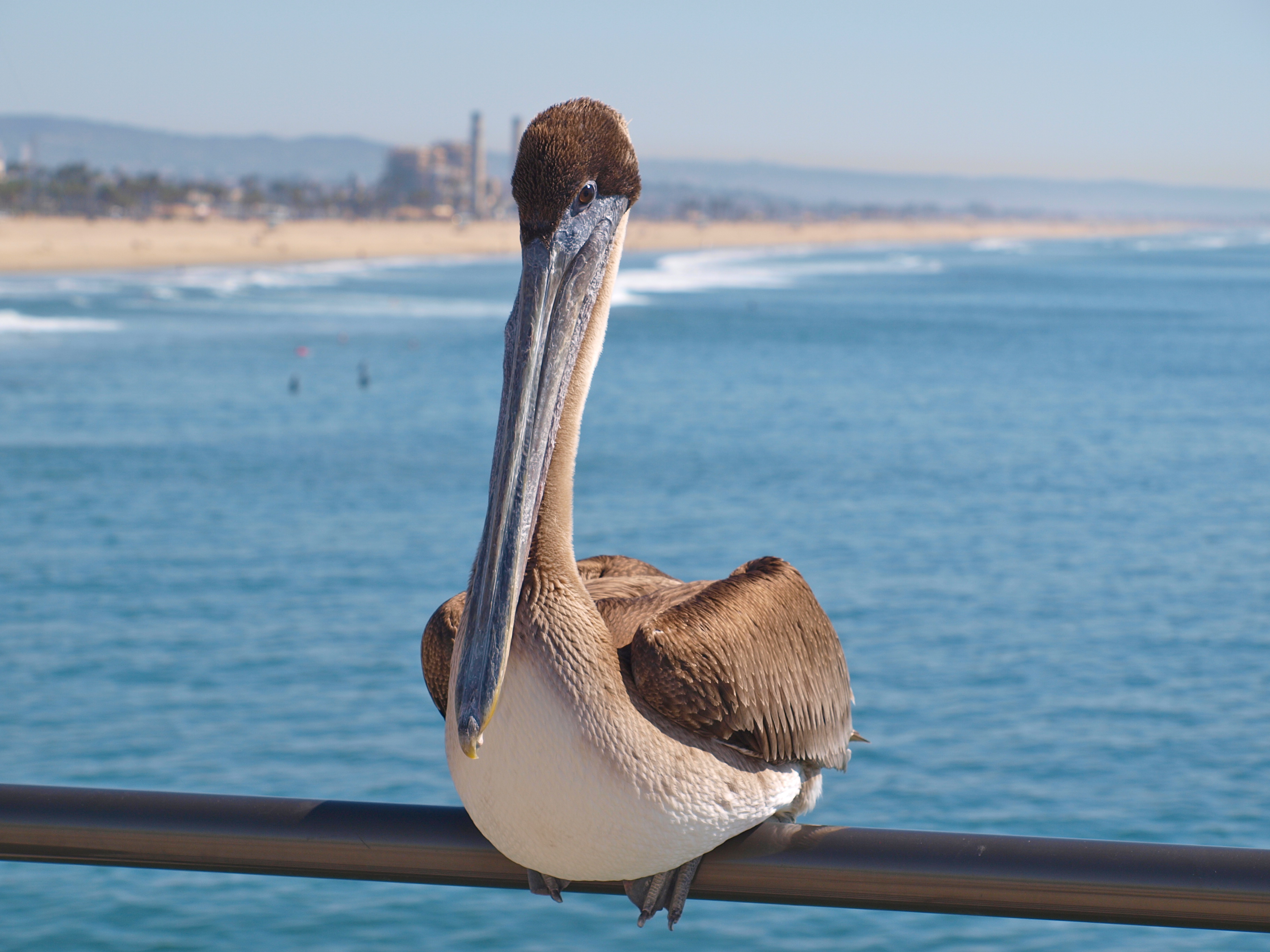
Hey bub, got an extra anchovy?
<*}}}}}}}}}>< — Fish surveys done by the California Department of Fish and Game from 2004-2009 showed a typical SoCal sandy-beach-pier mix of fish. Listed numerically — Pacific sardine (although only caught during one of the six years), barred surfperch, yellowfin croaker, Pacific mackerel, Pacific bonito (although only caught during one of the six years), walleye surfperch, jacksmelt, white croaker, spotfin croaker, topsmelt, queenfish, California corbina, shovelnose guitarfish, sargo, white seaperch, barred sandbass, striped seaperch, leopard shark, black perch, shiner perch, California grunion. Of interest to me was that the number of white croaker was only about one forth the number of yellowfin croaker. I think that number would have easily been reversed in the earlier years. The other interesting catch was the striped seaperch; I’ve never caught one from a similar SoCal pier. Unfortunately I think the survey is flawed since I do not think any surveys were taken at night. Thus the number of sharays would be far under-reported.
<*}}}}}}}}}>< — Some of the halibut caught at the pier have been big ones. This fish is probably still the largest.
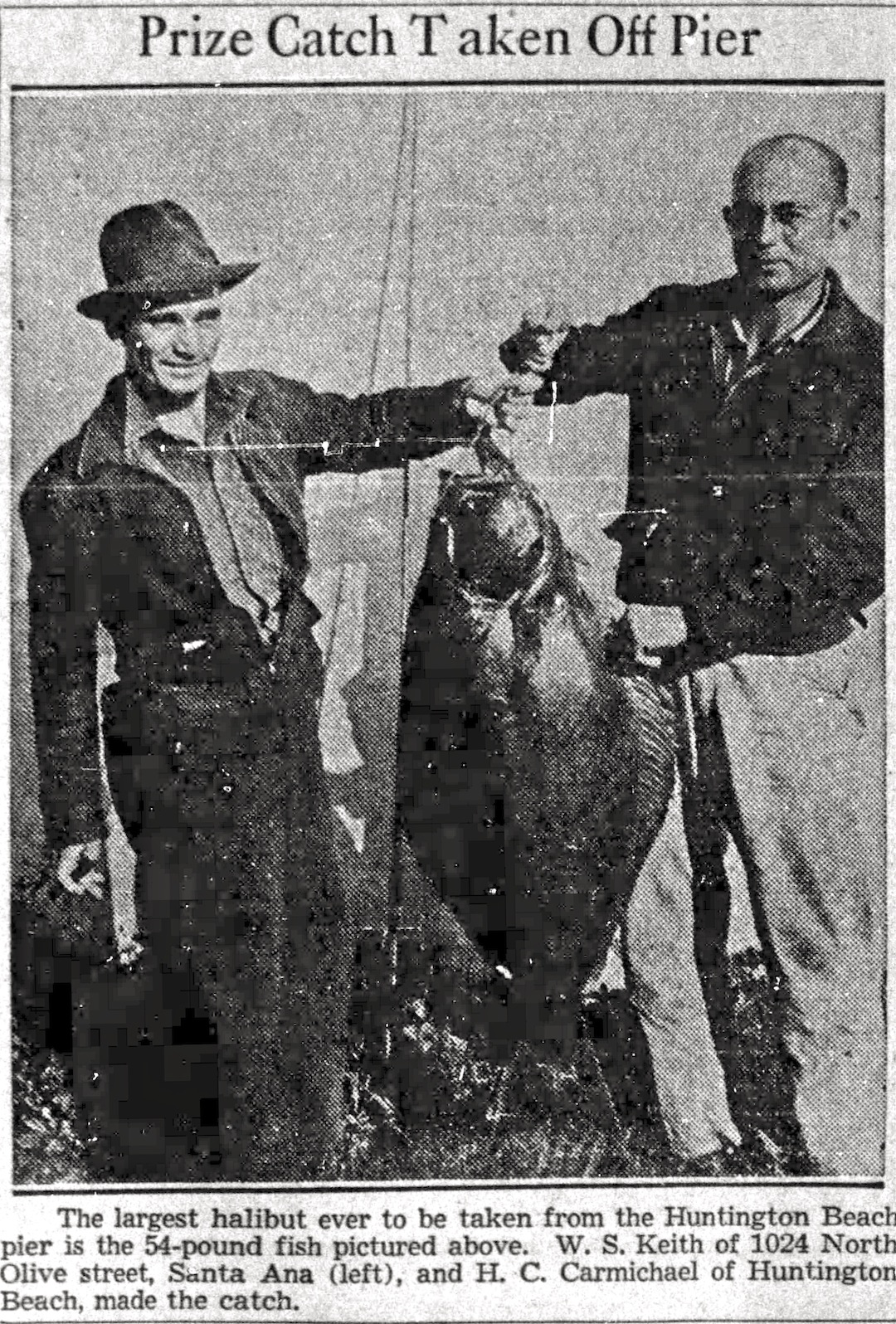
<*}}}}}}}}}>< — Sometimes reading the police files in the newspapers can be interesting. Huntington Beach Pier—A man reported his cellphone was missing after it fell into the ocean because he bent over the rail to reel in a fish he referred to as “the big one” at 12:02 p.m. Thursday. —Huntington Beach Independent, 5/27/04, Police Files. Two questions: (a) The reason you are calling 911? (b) Did you land the fish?
<*}}}}}}}}}>< — Not every pier has a “queen” but Huntington did. The following is taken from Justice For All, the Official Publication Of The Huntington Beach Police Officers’ Association.
“Ella Christensen 1913 – 2003
Ella was the ‘Queen of the Pier,’ the ‘Mom’ of the police department’s men and women. She had, for whatever reason, adopted every member of this police department and made them a part of her family. Just like a proud mother taking care of her children, this special individual went that extra mile every minute, every hour and every day. Ella was the owner and operator of several of the old concession stands, the Tackle Box, Captain’s Gallery and Neptune’s Locker on the pier until it collapsed in 1988, covering 37 years of service on the pier. Our favorite watering hole then, Neptune’s Locker was the best place to get a sandwich and cold mug of beer served up in glass-handled Mason jars after a long duty shift. People of substance and character such as Ella only come around but once in a lifetime. Because of her special character and support of us, we (the POA) awarded Ella, our ‘mother’, the 1st Annual Supporter of the Year Award in 1991. So, on behalf of so many of the members of the department, thank you Ella for your many years of kindness and generosity, and may you now rest in peace.”
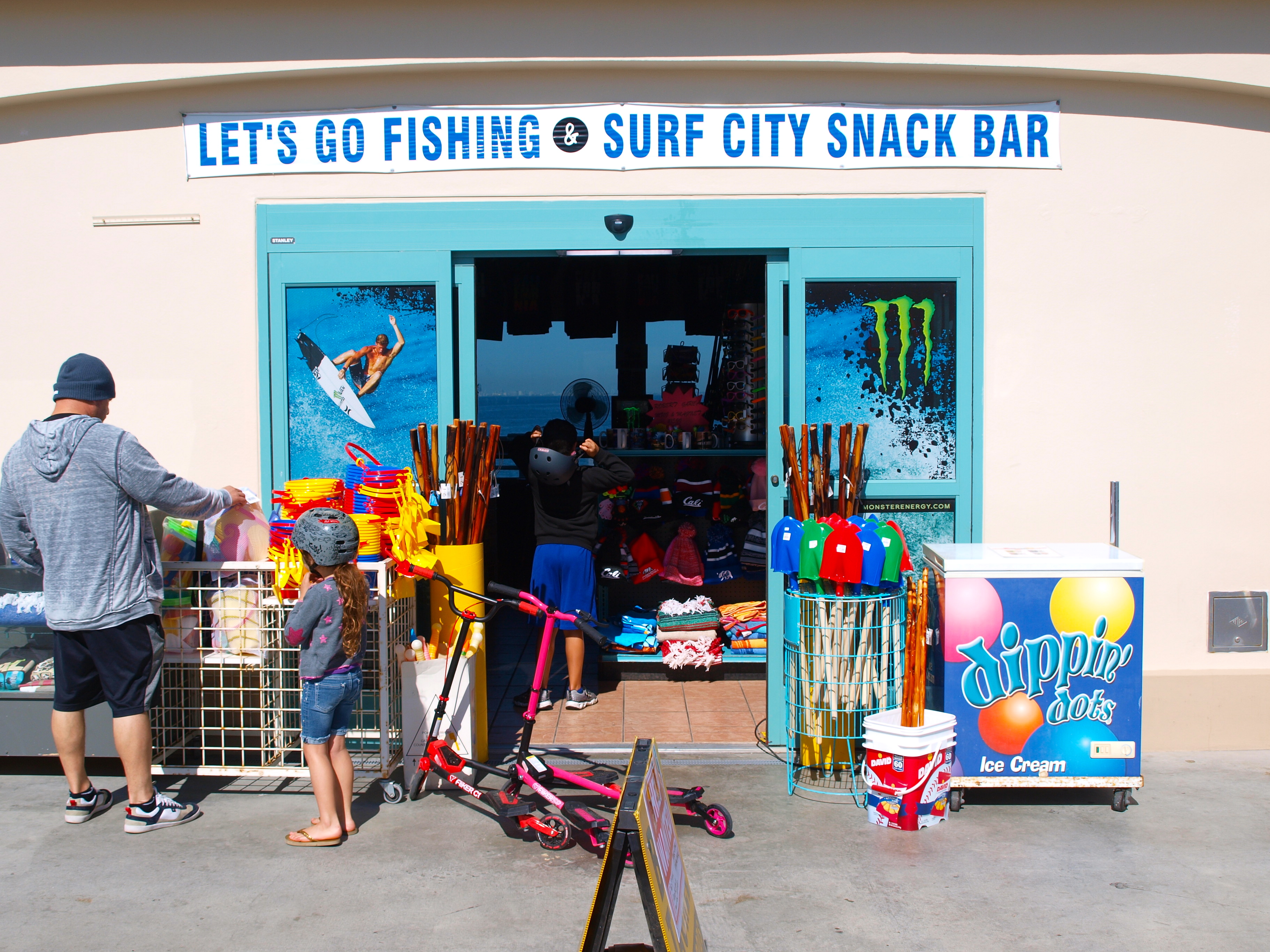
Lets Go Fishing — Where I get my monthly reports for the pier
<*}}}}}}}}}>< — Although it’s hard not to dispute a couple of connotations made by the writer of this newspaper article, especially regarding pier rats, it’s also a fascinating look at the pier and its characters
THE PIER IS A MAGNET — Communing with the sea or just a stroll in the sunshine? Whatever its attraction, Huntington Beach’s famous landmark draws all kinds.
Huntington Beach — An hour before she was supposed to slip behind her desk at work, Cindy Frickey leaned against the railing of Huntington Beach Pier and studied the surfers below. A strong morning breeze rolled through her long blond hair as she watched the surfers paddle their boards into position. If she had not been recovering from a bout with the flu, she might have been there too — wetsuited, finned, catching waves with a boogie board. But if she couldn’t ride the waves, she could at least feel the wind. “I like to come here before work.” Said the 26-year-old secretary. “I like to get the wind on my face, the sun on my body. I like to hear the ocean… it kind of blows my hassles away.” She had walked the 1,800 feet of concrete to the End Café for breakfast, talked with fishermen, sung parts of songs, climbed the steps to the lifeguard observation tower and now she had to go to her car and drive to Anaheim. As she walked, she was undisturbed. A pier rat — one of those ill-dressed, unshaven denizens of the dark — had not stopped her for loose change. A dope dealer was not there — “Want to get high, little girl?” No, this stroll on the pier had been idyllic and she could face the clack of her typewriter refreshed.
But not everyone had to work this weekday, a typical one at the pier. One who would not work today was Frank “The Happy Dragon” Finch, who would spend the morning and afternoon listening to the easy chatter of friends and the whistle of nylon line rushing through a fishing rod. The Happy Dragon? A lot of us who fish here have nicknames,” explained the 21-year-old machinist. “I got mine because of the tattoo here on my left forearm. “Some of the other nicknames?” Truant, Fat John, The Kid, Perch Bill, Corbina Bill, and Fish.
“There’s Two-Wheel John. He’s come here in an electric wheelchair once, twice a week. He says it takes a lot out of him, even with the wheelchair. He told me he lost his legs in World War II. His PT boat sunk just off Midway in the Pacific. His lifeboat was crowded so they took turns hanging over the sides of the boat. In the morning, his legs were gone, gnawed off by sharks. He’s got really big scars. You see the teeth marks.”
To Two-Wheel John, The Happy Dragon and the other fishermen who cast their lines from the end of the pier, Ruth Waller is Mom. “She’s everybody’s Mom,” said Finch. “I know she’s the closest thing I’ve got to a mom. She’s even Mom to the seals.” “We were up here fishing about three years ago,” explained Mom. “We saw a whole bunch of seals… a school… around the ones who was going to drop a pup. We actually saw the baby born… a beautiful thing to see. The mother and baby stayed around here three months. We named the baby Moe because we tried a lot of names and he seemed to respond to Moe. He came back every year around springtime. He’d come up to the end of the pier and call for us, scream for us. “We would throw him shrimp, anchovies. We were careful what we threw him. Not like another seal… people fed it everything and it got sick. Moe was my baby and I’d kill anyone who tried to hurt that baby.” “No matter where’d he be… under the pier… all I have to do is let out a yell. ‘Moe, where are ya?’ and he’d be right there. You know, they sense when you love them.”
The pier has also brought into Finch’s life such friends as J.J., a bearded man who wears a headband. “I’ve been coming here for 4 ½ years,” said J.J. “I’m a dry wall hanger. I come here when there ain’t no work… go fishin’ instead of spending my money in a bar. I’m very content here. I can sit here for 12 hours and never catch a fish. “It’s the little peace of mind I get. Not much of it around. Get it while you can. “Caught 20 yesterday and lost 20. I share the fish. I love coming here. Women say J.J. loves his fishing pole more than them. They’re right. This pole’s my old lady… takes care of me… feeds me.
Fishing also feeds Jerry Vaughan, 33, who works at The Tackle Box which sells and rents fishing equipment. “Worked here in and out since I was 11 or 12,” said Vaughan. “Get tired of a regular job and come here to relax. I’ve always been coming to the pier. As a kid, we sold starfish to tourists to raise money to buy our gear. We pulled mussels. We’d camp out. Fish shark all night. Wouldn’t go home for a week. Mother wasn’t too happy about that. Vaughan’s recollections were interrupted by fishermen who came into the store to order bait from a shopping list that included squid, night crawlers, red worms, and salted bonito. Then Vaughan rented a spinner pole and a bucket to Cherei Gable and Adam Birket, two college students. “I haven’t fished for at least seven years,” Cherei confessed.
When she went to the end of the pier to try her luck she was greeted by Mom, who broke off a bit of frozen anchovy and baited the rented hooks. “She’ll probably get a big one seeings as she hasn’t been fishing.” Predicted Mom. Although her line tangled, Cherei managed to hang onto her pole. “Tons of poles get dropped,” said Vaughan. “I pull up 18 to 20 a year. After they fall in I cast out and drag until I catch a line or pole. I help kids who’ve dropped their poles. They say I’ve saved their life. Their dad would’ve beaten them half to death.”
Poles aren’t the only things that fall in. “I remember this one man and wife who came in here,” Vaughan says. “She was flat driving him nuts — always talking, always contradicting him. They came in here a couple of times and she was really riding him. I heard he threw her off the end of the pier. If I remember, he got fined $50 or $100 for doing it. The lifeguards brought her up. She was pretty mad.” During his years on the pier, Vaughan has seen some not-so-funny sights too. “There are a lot more pier rats than there used to be” he said. “During summer, sometimes there were 70 guys milling around. You see them coming. They’re ragged looking. Panhandle… can hardly walk down the pier without being hit up. “I’ve seen more crime. Last year we were burglarized at least four times.”
Way out at the end of the pier, and appropriately named, is The End Café where proprietor John Gustafson has created a lifestyle centered on the sun and surf. “I’ve lived in the Huntington Beach area 15 years,” said Gustafson, 49. “Ten years ago I said I ought to buy this place. Two years ago I did. I left my job at Johnston’s Yogurt where I was general production manager. “The previous owner only opened this place during the profitable times but I keep it open even when it’s not so profitable.” Under glass on his counter, Gustafson has placed old photographs of Huntington Beach: a sugar beet field in 1911, the Union High School in 1927, oil wells, bathing beauties, swampland. And on the back of his menu is an old photograph of the pier. With it is a history: the pier’s initial wood construction, the destructive storms of 1906, 1919 and 1939, and the Army’s occupation from 1941 to 1945. “I love the history, the people,” said Gustafson. “I like the sunrises and sunsets.” During the evening’s sunset he stood outside his café with his wife Alice, a couple of amateur photographers, a pensive businessman, tourists, fishermen… and Cindy the secretary whose day ended as it had began: with a peaceful stroll down the pier. —Orman Day, Orange County Register, November 12, 1978
<*}}}}}}}}}>< — When you’re on the pier check out the pictures by the lifeguard office. One series shows wounds caused by round stingrays and the ways to treat the injuries. The pictures are rather gruesome but also educational.
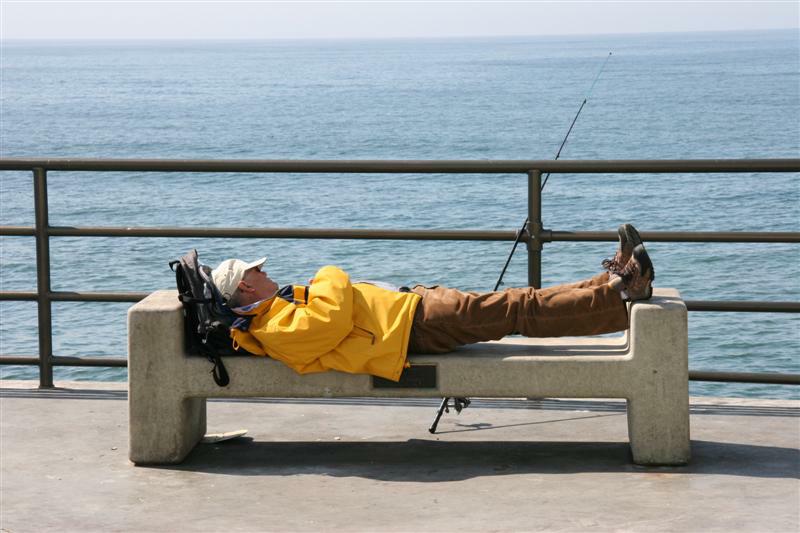
That’s one way to do it!
<*}}}}}}}}}>< — As mentioned previously, there can be an ongoing conflict between anglers and surfers, especially over the shallow water area.
Surfers caught in fishing lines want restrictions on pier — Fishermen say surfers should avoid the pier to solve problem.
HUNTINGTON BEACH – A local surfer who has been tangled in fishing lines near the pier wants the city to put restrictions on where anglers can drop their lines, but some fishermen argue surfers should paddle away from the pier. The long-standing conflict has pitted fisherman against surfer for years – each side claiming their territorial rights to the ocean. But one side will have to budge, said pier fisherman Jose Llamas, 30, of Huntington Beach. “Someone is going to get hurt,” he said. “They need to make a rule; either tell the fishermen to fish only on the south side or tell the surfers to surf farther out.” Lamas added the declining economy has drawn more fishermen to the area, heightening the possibility of a serious incident. “There are now a lot more people out here catching their food,” he said.
Standoff Becomes Fisticuffs — The standoff between anglers and surfers recently turned physical, prompting a local surfer to bring it to the city’s attention. Stephen Stemmer, 23, of Huntington Beach said on July 23 a fisherman followed him home and attempted to assault him after an incident on the water. While catching a wave, he found himself tangled in a fishing line and couldn’t unravel the clear cord fast enough so he snapped the line, he said. “The next thing I know, the fisherman was cursing at me and throwing things,” he said. “It got heated.”
Stemmer headed home nearly an hour later – a five-block walk from the pier – when he heard rapid footsteps behind him. “I turned and saw the fisherman running after me, and he came in for a punch,” Stemmer said. “I used my board and towel to fight him off.” Police responded and wrote it as a citizen’s arrest. They will give the case to the District Attorney’s office, said Huntington Beach Lt. Russell Reinhart Stemmer last year asked council members for help after getting caught up in fishing lines multiple times, one that resulted in him slicing his hand open so he could break free, he said. He approached the council again at the Aug. 3 meeting to petition for fishing restrictions. “It could be prevented but (the city) does nothing,” he said. “That’s why I’m so heated about this.”
Can’t We All Just Get Along? — Marine Safety Officer II Eric Ching said he would guess incidents between the two groups happen almost daily. “It’s kind of like, ‘Can’t we all just get along?’” Ching said. “The fishermen will tell you that is where the best fishing is … and the surfers will tell you that’s where the best waves are.” Ching said the pier and the water surrounding are designated as a multiuse area, and the two groups have to cope.
“The fishermen are responsible for their lines, and surfers are responsible for being aware of their surroundings,” he said. But Stemmer said requiring fishermen to move down the pier would deter any future conflicts. He wants fishing moved to the “second T,” which is near the bait and tackle shop about halfway down the pier. “When you’re catching a wave, those fishing lines are like a spider web… it’s kind of like you’re dodging it, and next thing you know you’re caught up in a line,” Stemmer said.
However, some fishermen say they fish in shallower waters because the catch is better. “I think what they’re asking is unreasonable, they have the whole ocean,” said Junior Cortez, 17, of Santa Ana. “This is where the fish feed and it’s easier to catch.” Cortez added he heard of Stemmer’s recent incident and wasn’t surprised it escalated as it did. “This upsets the fishermen,” he said. “It gets expensive. When they break the line, I lose my bait, my hook, my weight and my line.” Stemmer said he doesn’t buy the rationale behind fishing near the breakwater and anglers could thrive in deeper waters. “There are fish all around this pier,” he said. “They don’t need to do it right here.”
Where The Surf Meets The Fish — Marine Biologist Camm Swift said both groups are correct, in a way. Pier pilings caked with mussels and other sea creatures attract fish to areas all around the pier. Certain fish are attracted to the surf such as corbina and surfperch. “It’s (about) different kinds of fish,” he said. “The surf zone is kind of its own habitat,” said Swift. “If you go farther out on the pier you get sharks, croaker and halibut.”
Stemmer added that some surfers have been hooked in the leg or foot and have had lines wrapped around their necks. “(The city) makes fishermen pull the lines up for the US Open on the south side and when the Junior Lifeguards do their pier swim, so obviously they know it’s a safety hazard,” he said. “So why aren’t they concerned for our safety?” Surfers paddle in alongside the pier because a current, called a tow out, helps pull the surfer to the break line. From there, they paddle away from the pier to catch a wave. The pier is a premier spot for experienced surfers who want a good ride, Stemmer said. “I’ve been surfing here forever,” he said. “This is Surf City, right?”
Ching said there have been times when surfers and fishermen instigate conflict and both groups should be responsible with their respective sports. “Surfers have cut lines when they don’t need to. That is illegal and that is not a way to solve a problem,” he said. “There have been incidents when fishermen are being the aggressors, casting their lines at surfers, which is totally illegal and dangerous.” Llamas said he has witnessed at least five large fights between the surfers and the fishermen over broken lines. “They think the whole beach belongs to them,” he said. But he said he believes something could be worked out. “I respect them… I think we could get along together.” —Jaimee Lynn Fletcher, The Orange Coast Register, August 14, 2009
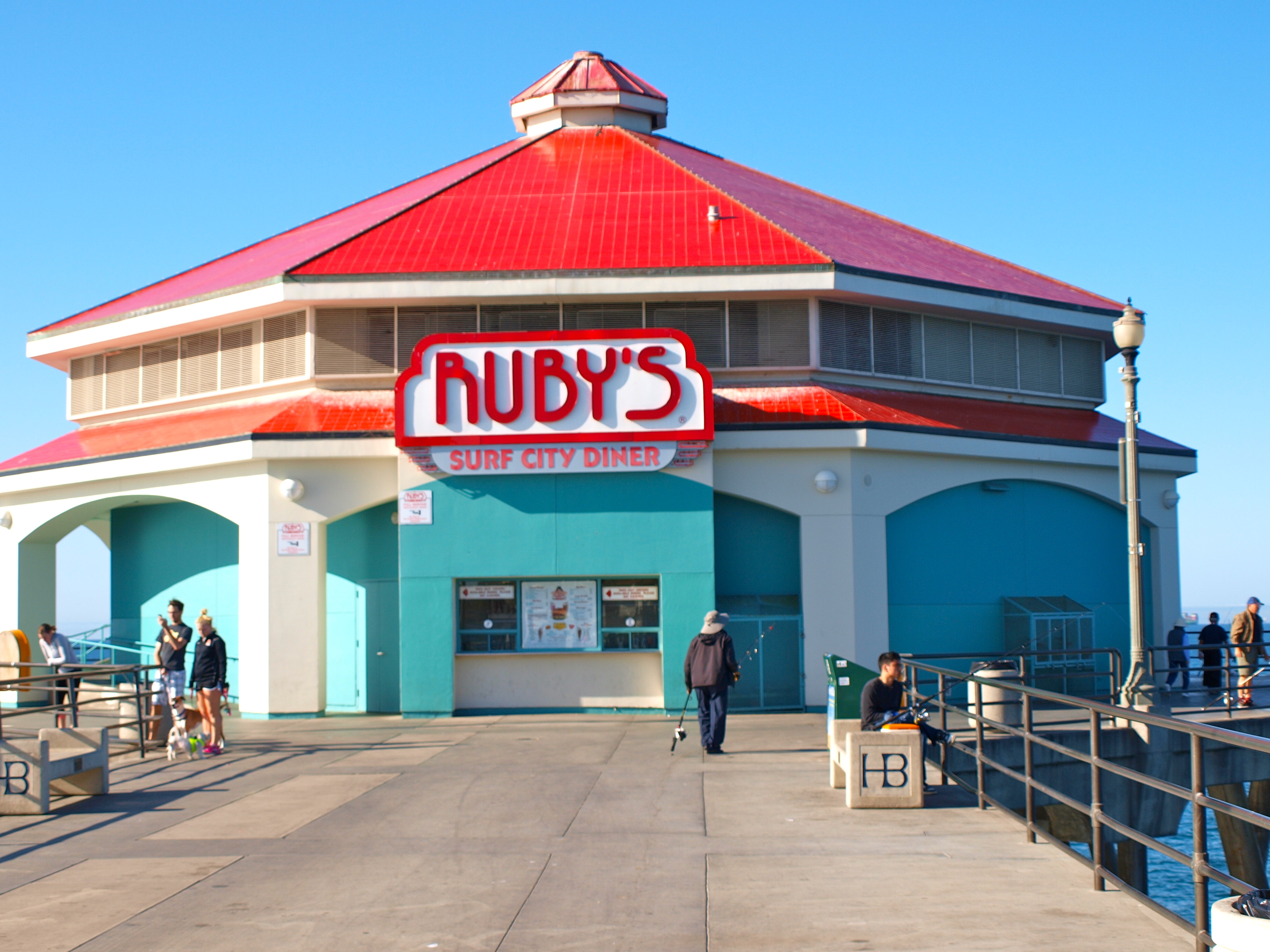
<*}}}}}}}}}>< — Just to be clear, it’s not all that uncommon to see conflict between residents and visitors in seaside towns. In California, where the divide between the haves and the have not’s continues to widen, especially in relation to where they can and cannot live (inland prices versus coastal prices), it’s a greater and greater problem and creates increased tension.
In Huntington Beach, a new wave of resentment revives ‘909er’ stereotype
On a sunny September day, Christina Ayres lay on the sand near the Huntington Beach Pier, tanning in a pink bikini, and ticked off the things that identify a 909er. Bad clothing — “’Jersey Shore’ style,” the 29-year-old explained. And meth addicts. “That’s what you hear on the news.” Over on Main Street, Ryan Kaupang, 21, had a more specific description: “White kids that dress like bros,” he said, “bros” meaning people who wear cut-off jerseys and motocross gear and “try to act like tough guys.”
For years, a stubborn divide between youth in Orange County’s beach communities and those who visit from the inland has been summed up in the term ‘909ers,’ a less-than-flattering reference to an Inland Empire area code that — in beach slang — has come to mean anybody east of the county line.
Its popularity has waxed and waned but resurfaced with a vengeance in the aftermath of the U.S. Open of Surfing in Huntington Beach in July. When the week long event ended in a chaotic night of broken windows, street fights and a mess of tossed food, word that 909ers were to blame spread quickly among locals, despite the fact that only three of the 12 adults arrested were from the Inland Empire. The rest were from Orange County, San Gabriel Valley and Ventura.
By the next day, residents in Huntington Beach and neighboring beach towns pointed toward the Inland Empire as the source of the bad behavior. Someone even created a Facebook page called Go Home 909ers, warning that “Southern California Beaches are for LOCALS ONLY.” When an end-of-summer beach rave was staged this month, some worried about the 909ers it might attract. Though the event drew thousands, there were few problems.
“I hate the term ‘909ers,’” said Connie Boardman, the beach city’s mayor. “Like it’s some crime to be from some other part of California and come to our beach.” Yet a stereotype based on an area code persists.
Some say ‘909er’ is used as a slur. Others say it’s just used in jest. But in Huntington Beach, there is no escaping the 909 — or the 951, the 760, or any other area codes from which the city’s 15 million tourists arrive every year. This is a city that thrives on tourism but has an increasingly tense relationship with tourists. There is no agreed-upon definition of a 909er. For some, it’s just a catchall for the Inland Empire. For others, it conjures up an image of young people absorbed with dirt-bike gear and lifted trucks.
Urban Dictionary takes its own shot at the 909, describing it as “a great place to live between Los Angeles and Las Vegas if you don’t mind the meth labs, cows, and dirt people.”
For the 21-year-old grad student who created the Facebook page, the tipping point was the night of violence on Main Street, which he insisted was caused by 909ers. “We’re trying to defend our beaches from people that don’t live there. People that come down to destroy instead of protect,” he said, declining to give his name because of the possible repercussions. “I’d prefer if they just didn’t come at all.”
Susie Smith, owner of Makin Waves Salon on Main Street, said some visitors seem to “come with a chip on their shoulder and think we have more things or a better life than they do, and they don’t respect our community.” She conceded, though, that labeling people from the Inland Empire ‘909ers’ may not help ease the tension. “Maybe it’s causing some rivalry,” she said. “Maybe people come from these areas with an attitude because Orange County is labeling them.”
When the 909 area code was created in 1992, it quickly gained a negative reputation. “The 909” was used on TV shows and by comedians as shorthand for a low-class community. “There’s a very close connection between the Inland Empire and Orange County simply because geographically they border one another. So there’s that county rivalry,” said Susan Phillips, assistant professor of environmental analysis at Pitzer College, which sits firmly in the 909. In reality, she said, both regions are much more diverse than stereotypes would have us believe. Still, many western Riverside County residents could barely contain their joy in 2004 when their area code was changed to 951.
Tourism is the lifeblood of Huntington Beach. In addition to the U.S. Open, where crowds get so thick it’s tough to walk on the beach, the city hosts an annual national paintball tournament that attracts tens of thousands. There are volleyball tournaments, food festivals and ample parking for the millions who come just to spend a day at the beach, under an umbrella, huddled around a bonfire or soaking up the nightlife on Main Street at night.
On a recent Thursday, dozens of residents in Hawaiian shirts and shorts packed a Main Street library room to talk about the city’s downtown. They cited a litany of horrors brought by visitors to what locals say is an increasingly raucous Main Street night scene: fights in the early morning hours, vomiting in the streets, urinating in the bushes. —Paloma Esquivel, Los Angeles Times, September 21, 2013
<*}}}}}}}}}>< — Where once there were oil wells today there is a modern and increasingly upscale, expensive city. The pier is large and impressive as are the areas at the foot of the pier.
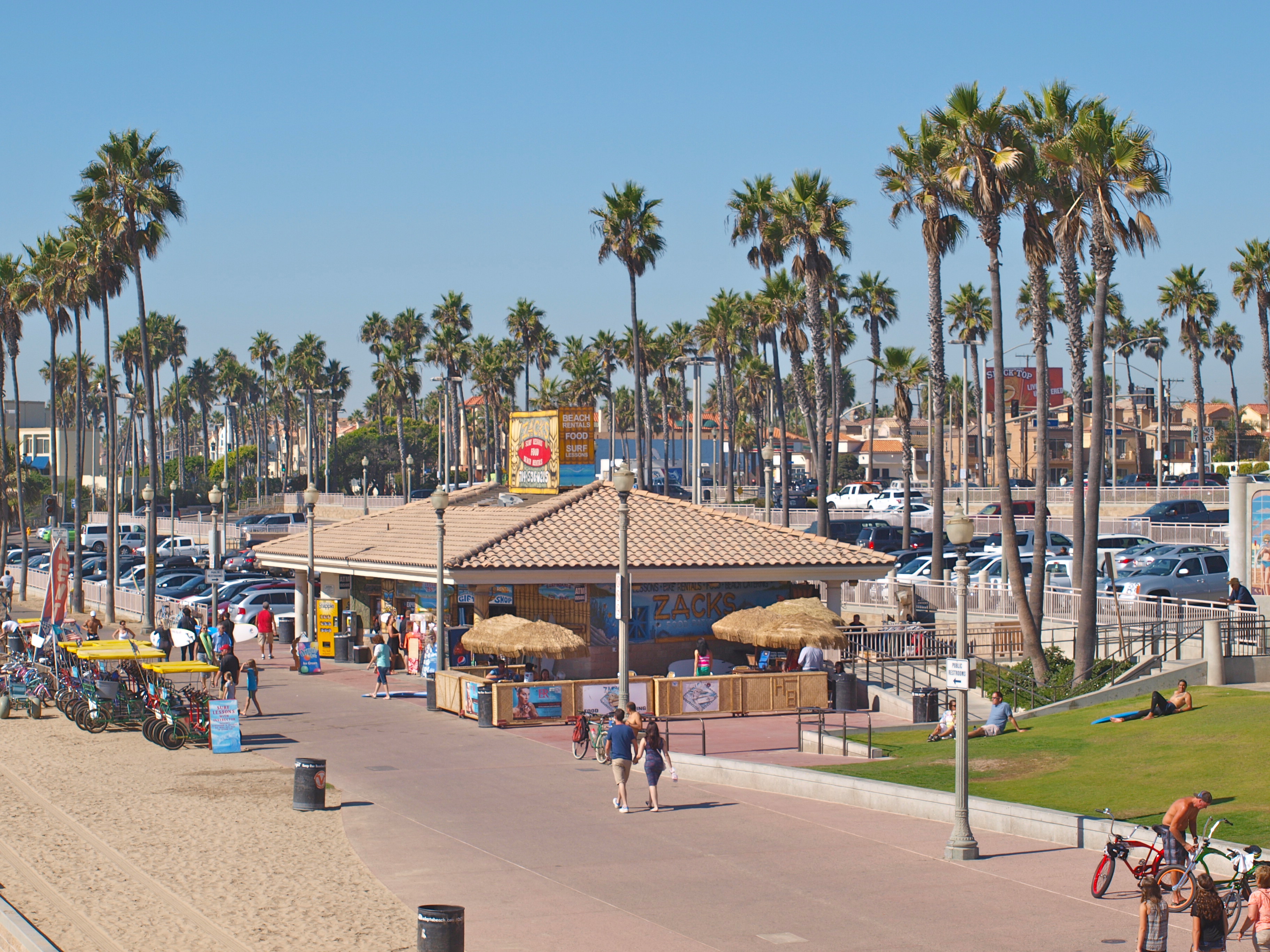
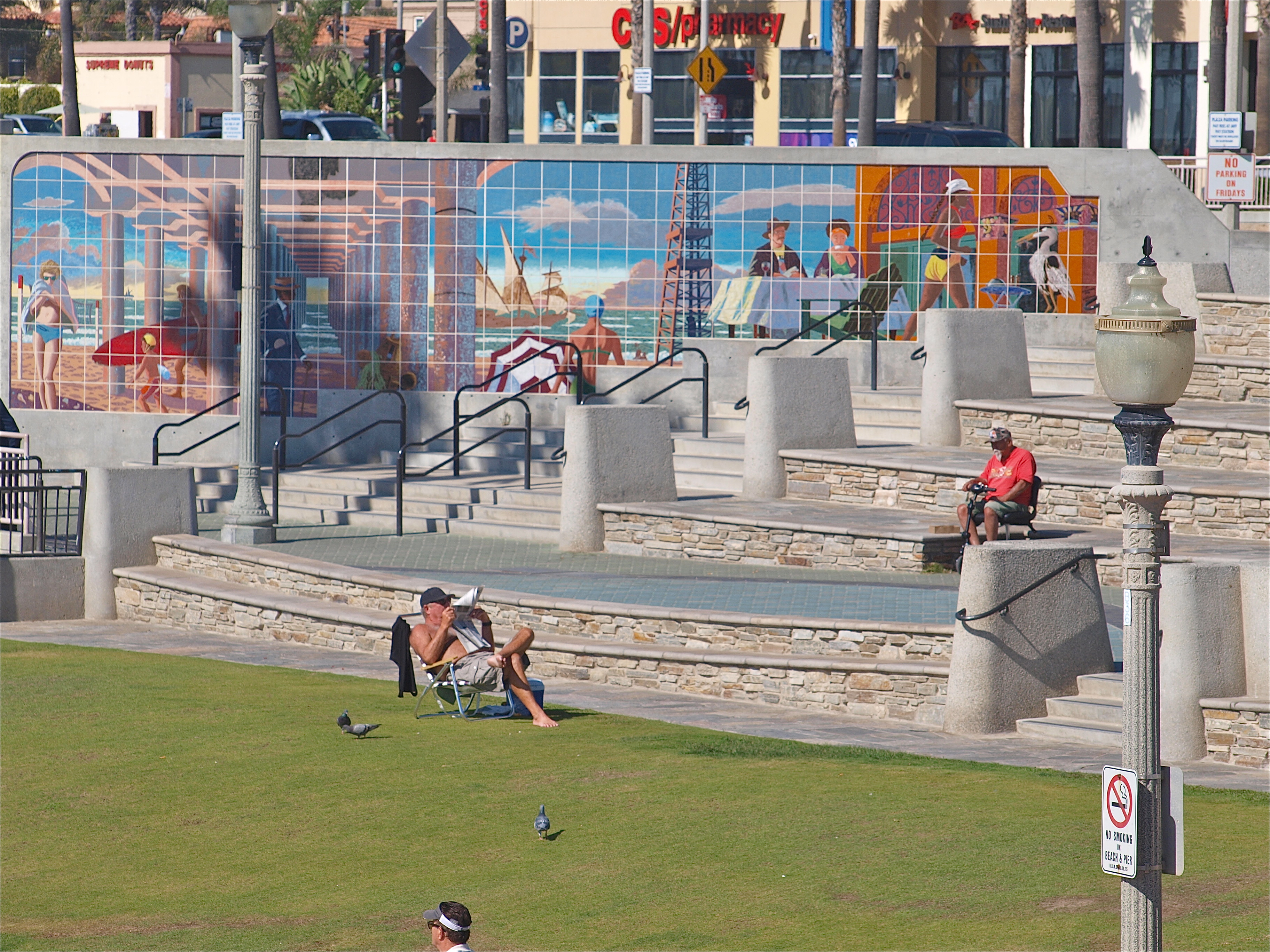
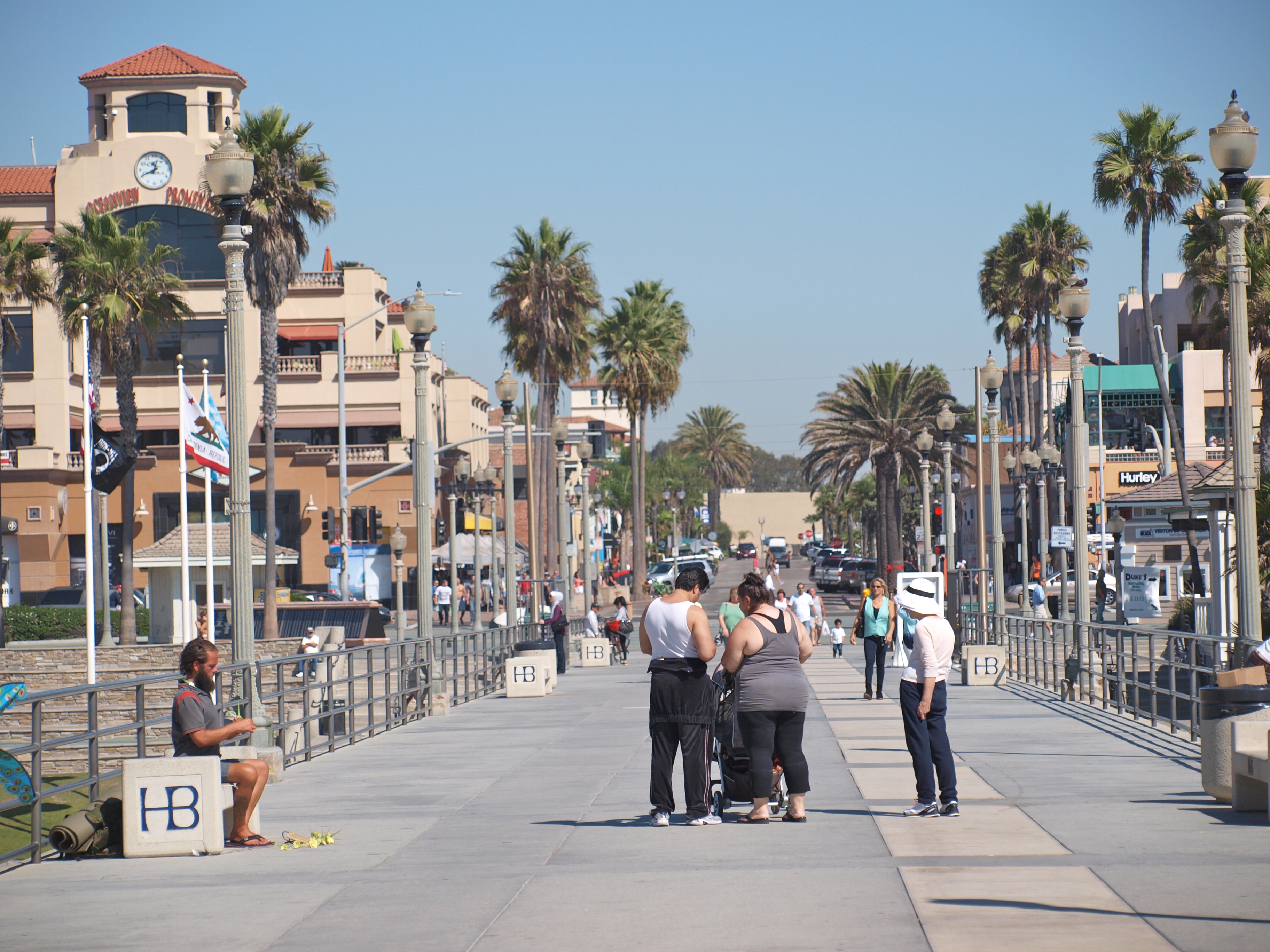
History Note. The history of Huntington Beach exemplifies what happened to many seaside areas in California in the 1800s and early 1900s. Much of the local area was originally part of the “Nietos Grant” given to Manuel Nieto by the Spanish government. In 1834, part of the land was split off as Las Bolsas (the pockets of bays), and later, in 1843, a new split created Bolsa Chica (the little pocket).
In the 1850s, after the creation of California, much of the local land was acquired by Abel Stearns, a trader in Los Angeles. In 1894, a drought caused Stearns to turn over part of his land to a trust and eventually part of it was purchased by Col. Robert J. Northam.
In 1900, the area was visited by the person who was probably most important to the founding of the city. His name was Pililip A. Stanton, the founder of Seal Beach, and later Speaker of the California Legislature. He visited the local beach (then called Shell Beach because of the numerous bean clams that dotted the beach) together with S.H. Finley, a Santa Ana engineer. According to the popular legend, Stanton expressed his belief that the climate and beach rivaled the East Coast’s famous Atlantic City. “Let’s build a city here and call it Pacific City,” Stanton said. Finley agreed and soon the West Coast Land and Water Company was formed. It purchased 1,500 acres of land, began to lay out streets, built a pavilion on the ocean front, and by August the first lots of Pacific City were ready for sale.
“Build it and they will come” did not prove true — sales were slow! Company directors soon became convinced that transportation was needed to their “Wonderland by the Sea.” Stanton sold his shares in 1902 and his fellow investors began to court a partnership with Henry Huntington, the owner of the Pacific Electric Company and its electric powered “Red Cars.” In exchange for extending his inter-urban electric railway, Huntington was offered stock in a new company at an unbelievable 17 cents a share, free right-of-way along the ocean front, one-twelfth of all subdivided lots, and one-fifth interest in all ocean front bluff property. Nevertheless, Huntington was still reluctant until told the company and city would be named after him. In May of 1903, the Huntington Beach Company was incorporated; it purchased all the holdings of the West Coast Land and Water Company, and an additional 1,400 acres. Pacific City now became Huntington Beach. When the “Red Cars” finally arrived in Huntington Beach, on July 4, 1904, there was a huge celebration with more than 50,000 people and land sales began to boom. The boom began to fizzle by 1905 and by 1909 Huntington withdrew his support. However, the city grew and the Pacific Electric continued to run its railway line until 1961.
Most important for our story, 1903 saw the construction of a wooden pier, approximately 1,000 feet long, at the end of Main Street. Nearby, on a bluff, set the Huntington Inn. A plunge was built west of the pier and a band stage was built on the beach between the pier and the plunge. The pier was built of untreated lumber and suffered attack from various marine organisms which weakened the structure. Nevertheless, that original pier was to last until 1912 when a storm demolished the middle of the pier.
A $70,000 pier construction bond was soon approved and a new 1,350-foot-long concrete pier was dedicated on June 20-21, 1914. The local Huntington Beach News proudly proclaimed: “Pier Celebration Was Gigantic Success; Twenty Thousand Visitors Entertained; Fifteen Hundred Automobiles Here Sunday.” On the front page were “Three views of the Longest, Highest, and Most Artistically Designed Solid Concrete Pier in the World.” Festivities that day included a concert by the Municipal Band of Long Beach, swimming and diving events, a “surfing” demonstration by legendary board rider George Freeth, a casting tournament by members of the Southern California Rod and Reel Club, and Japanese fencing and sword dances. At 7:30 the lights on the pier were turned on and a carnival band played for a dance and “serpentine battle” out at the end of the pier. A 500-foot extension, together with a restaurant at the end, was added to the concrete pier in 1930.
Like most southern California piers, sportfishing operations, usually in the form of fishing barges, were headquarted on the pier. Here it began in the ’30s with the Annie M. Rolph and the appropriately named Huntington barge. After World War II and into the 1950s, the pier would have a series of new barges — the Elsie I, Elsie II, Neptune, Swallow and Varga.
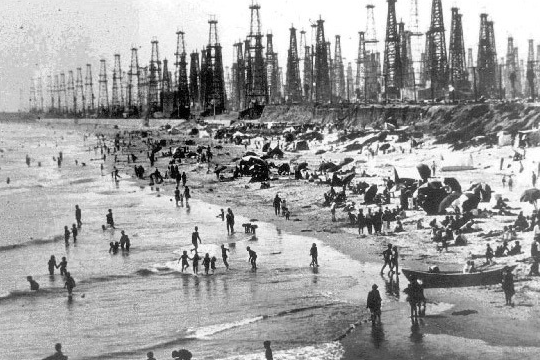
The new pier would last more than seventy years. It did however suffer occasional damage. In 1933, an earthquake damaged part of the pier, and in 1939, a tropical hurricane destroyed 300 feet of the far end of the pier.
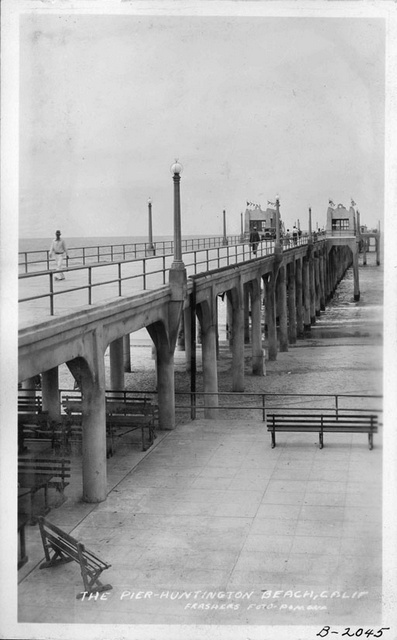
The pier in 1935
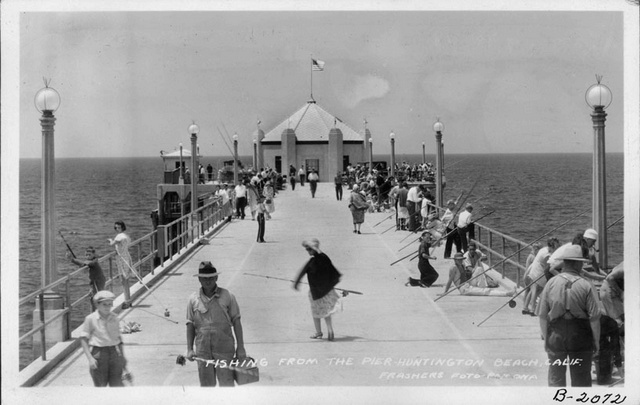
By August of 1940, the pier had been restored to a length of 1821.8 feet. Next came World War II and concern about a Japanese attack. The town and pier were occupied by the army and pier attractions now included machine guns, radar and a radio station.
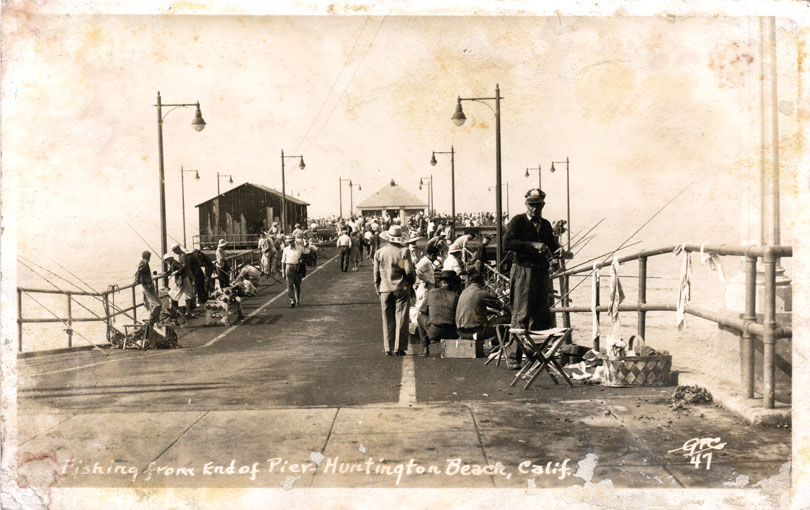
Fishing the pier — 1947
In 1939, the Pavilion dance hall was built near the left entrance to the pier. It quickly became a local center for the swing and jitterbug of the big band era. In 1941, it was renamed the Pav-A-Lon, a play on the word Avalon. After WWII, it served as a hall for concerts and festivals and then, in 1955, was converted into a skating rink. In 1966 it became The Fisherman restaurant, and still later, in 1976, it became Maxwell’s, a restaurant and center for live jazz. By 1947, there was also a “Fun Zone” adjacent to the pier which included a few rides and a Pier Cafe on the right side of the pier.
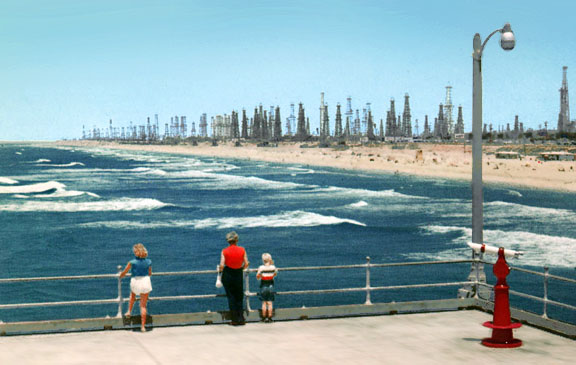
A view up the coast
The pier itself suffered damage in 1958 when a storm damaged the final 600 feet of the pier, but it was soon repaired.
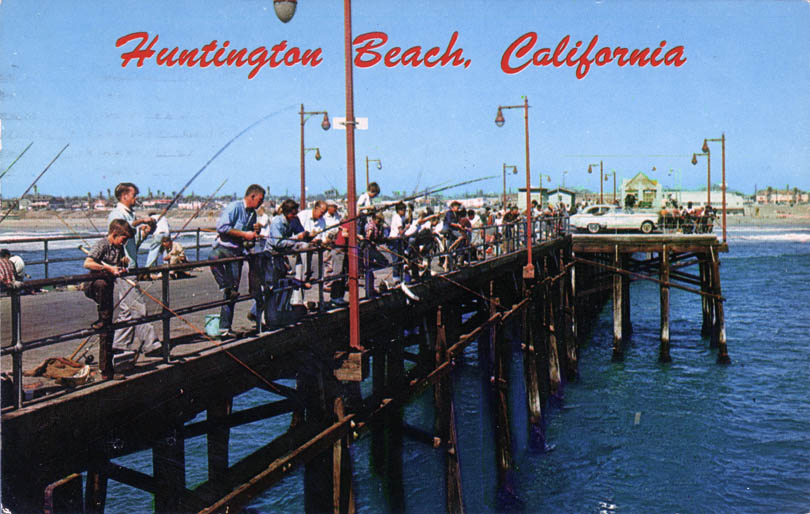
The way it looked when I first fished it in the ’60s
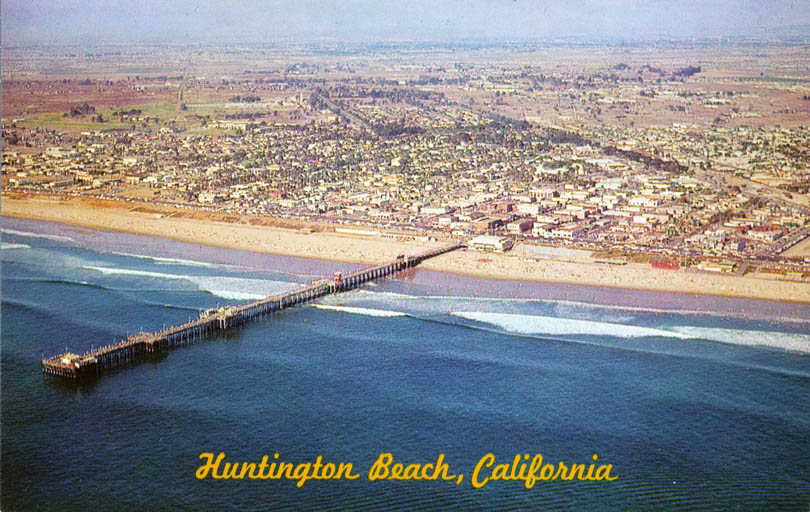
But all good things must come to an end (sounds trite)! The combination of huge El Niño storms in 1983 (which necessitated $1.4 million in repairs), a winter storm in 1988 (which washed away the final 250 feet of pier — including the landmark End Cafe), and simple old age, brought an end to the majestic old pier.
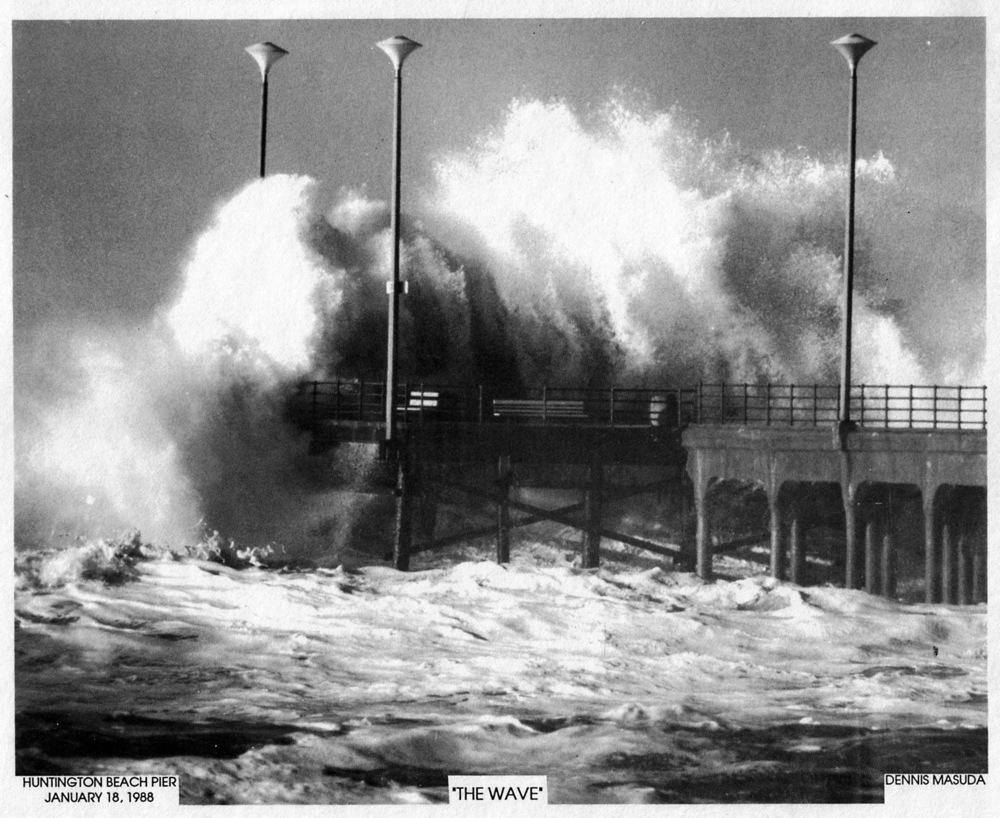
A new Huntington Beach Pier reopened in the spring of 1992 after a lengthy closure and expensive ($10.8 million) repair and refurbishing. Included in the new pier was a diamond-shaped end designed to (hopefully) better deflect incoming waves.
But change continues. In 1996, a large Ruby’s Restaurant opened at the end of the pier and became an instant success. Then in 1997, Maxwells was torn down to make way for a new $12-million Pier Plaza and promenade. Maxwells was turned into Duke’s Surf City.
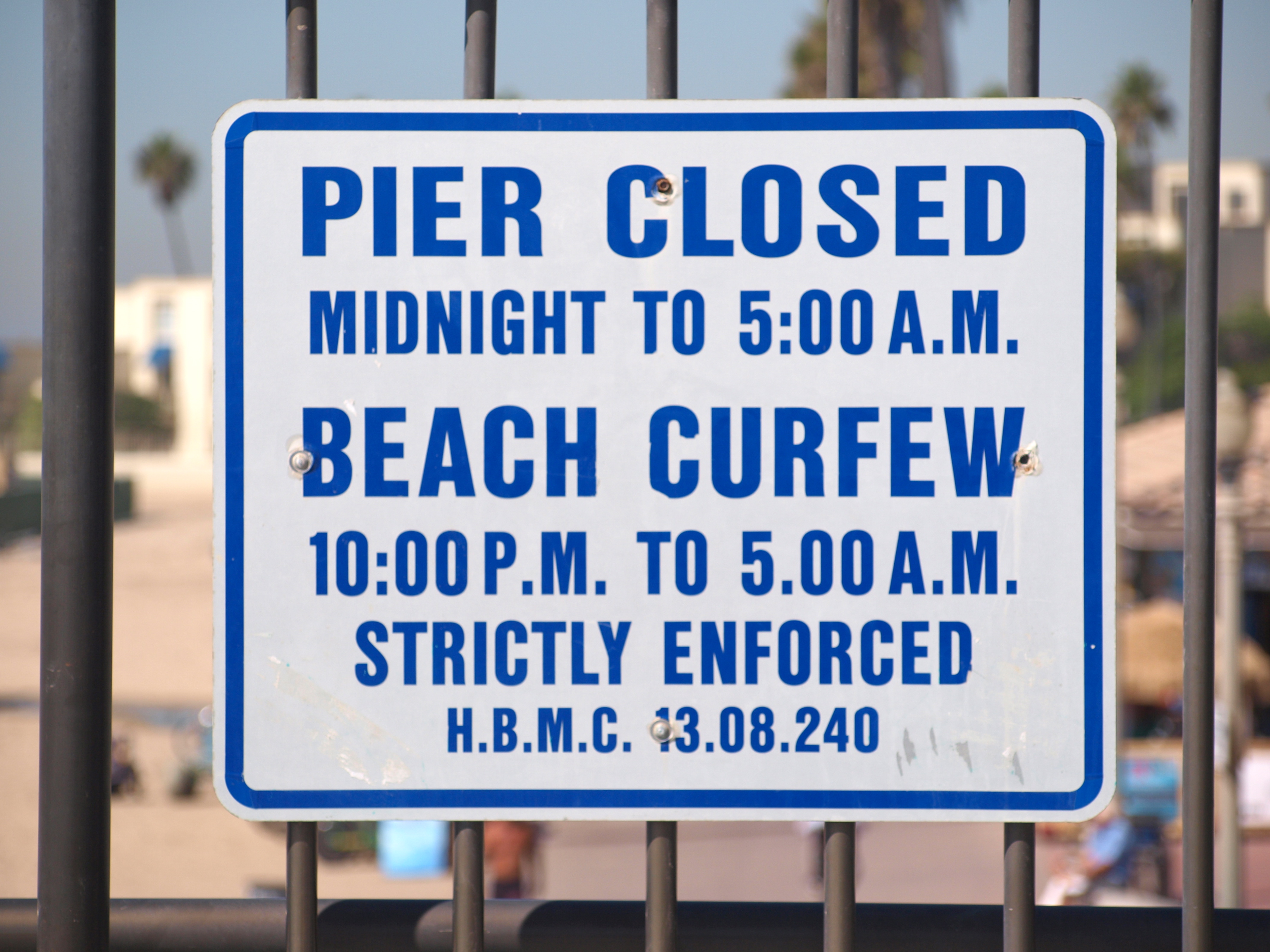
Huntington Beach Pier Facts
Hours: The pier is open 5 a.m. till midnight.
Facilities: Lights, restrooms and a fish cleaning station are located on the pier. Parking is available adjacent to the pier for $1.50 an hour and there is some metered parking on nearby streets ($1.00 an hour with a six hour maximum length of time). Ruby’s Surf City Diner is located out at the end of the pier and although somewhat ugly from the outside, it offers generally good food for a reasonable price — the same as the Ruby’s on the Balboa and Oceanside piers. The “Let’s Go Fishing” bait and tackle shop and its “Surf City Snack Bar” are located mid-pier.
Handicapped Facilities: Handicapped restrooms. The pier surface is cement with a 30-inch rail height. Posted for handicapped.
How To Get There: Highway 1 (Pacific Coast Highway) to Huntington Beach and the pier. It is located at the end of Main Street.
Management: City of Huntington Beach.
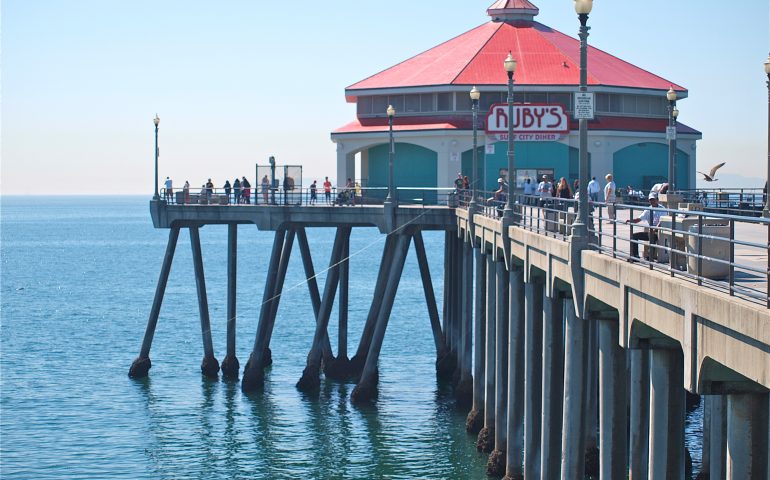
[…] Huntington Beach Pier Facts. Hours: The pier is open 5 a.m. till midnight. Facilities: Lights, restr… […]
[…] Huntington Beach Pier […]
Wow such a great and best post!